
FREE THEMISSIONFLYMAG.COM ISSUE 45 MAY/JUNE 2024 DAVID GRAVETTE, MOHAWK PUNK KWAN, THE GRUNTERIST, BEN’S DAM, SHAUN DICKSON, BEATS & MORE
3 years in development
16 Iterations of material packages
8 different variations of slickness formulas
And over 2500 hours of field testing

“ “ SCIENTIFIC ANGLERS MAGNITUDE CLEAR FLOATING
LINE USHERS IN A NEW ERA OF FISHING TECHNOLOGY –THE HEADACHES WITH CLEAR LINES ARE A THING OF THE PAST!
-David Mangum

ALL TO GET TO THIS POINT
Introducing The New Magnitude Clear Floating Fly Line
Duracoat
Specialized dual-polymer design optimizes line stiffness, slickness, and abrasion resistance while significantly reducing line memory and tangles.
Clear Floating Technology
Clear Floating Technology uses naturally buoyant polymers for the ultimate in stealthy presentation and best-in-class durability.

EST +
EST+ - proprietary slickness additive that provides unmatched durability, smoother shooting, and eco-friendly performance.






Throw Some Shade

















Tropic Comfort Natural Hoody




The best gear inspires confidence. It’s comfortable, knows its job and pulls with you for years. Our Tropic Comfort Natural Hoody is the essential fishing top. Details include 40+ UPF sun protection, a generous hood, thumb holes for hand protection and a relaxed fit that won’t hamper your casting stroke. Constructed primarily from fabric derived from beech tree pulp, the Tropic Comfort Natural Hoody is the natural evolution of a fly fishing classic.

Learn More
 Photo: Sometimes, they’re just where they’re supposed to be. Austin Campbell
finds a biggie behind a boulder in Colorado. Andrew Burr © 2024 Patagonia, Inc.
Photo: Sometimes, they’re just where they’re supposed to be. Austin Campbell
finds a biggie behind a boulder in Colorado. Andrew Burr © 2024 Patagonia, Inc.

ALASKA PROVEN. BUILT
ALL.
FOR

FEEL ALIVE OUTSIDE.
XTRATUF® boots are built for the worst, so you perform at your best.
www.xtratuf.co.za

30. BEN’S DAM
Living in the Cape (where smallmouth bass are a guilty and furtive pleasure) Conrad Botes offers up his kuier kidneys in exchange for a shot at smallie heaven.
36. ALL YOU CAN EAT - EASTERN EUROPE
The trips that remain seared into your memory are the ones that provide challenging yet hugely rewarding fishing AND quality vibes with your mates. That’s what Rob Scott and his friends experienced as they toured Slovenia, Bosnia and Croatia.
46. THE GRUNTERIST
What does it take to become a grunterist? What does it mean to be one? And is it a good idea in the first place? We may never have had this cautionary tale, were the whole process not witnessed by A Lucid & Restless Bystander
56. PROFILE - DAVID GRAVETTE
Pro skateboarder turned frothy fly fisher David Gravette speaks to The Mission about sucker love, catastrophic injuries, cyberphobia and toe pin Clousers.
92. THE SOURCE
Twenty years in the making, Samuel Fretwell and his son encounter the Dadès trout and find the heart of their passion on a river high in Morocco’s Atlas Mountains.

Between losing his mind, wader/bladder mishaps and spot-burning his own local waters, The Grunterist accounted for a few fish. Read about his legend on page 46.
12 Ed’s Letter 16 Chum 20 Wish List Fish 22 Troubled Waters 24 High Fives REGULAR FEATURES 72 Salad Bar 82 Pay Day 86 Fluff 100 Tribute 104 Pop Quiz WWW.THEMISSIONFLYMAG.COM ISSUE 45 MAY/JUNE 2024 CONTENTS
Cover: Pro skateboarder David Gravette with a shiner that ressembles a redfish spot. (page 56). Photo. Drew Wilson.



It’s about distant rises, perfect casts, slow motion eats and hook ups you will never forget. Introducing the new Avantt II , relentless innovation, uncompromising performance. magic moments… www.thomasandthomas.com HANDMADE IN AMERICA THE ROD YOU WILL EVENTUALLY OWN est 1969
BE LIKE TOM

“Looking back on my life, if there was one thing I would do differently, I would be less consumed with guilt about spending time on myself and what I like. Read into that, if you like, to have done more fishing.” Tom Sutcliffe, The Lifer in The Mission Issue 04.
By almost anyone’s standards, South African fly fishing legend Tom Sutcliffe who passed away recently did a lot of fishing in his illustrious life, while also managing to be a loving and involved husband, father and grandfather and a revered leader in medicine and civil service. Yet still... he suffered from that universal fly angler’s condition of feeling like he really should have spent more time fishing.
Tom was very good to us at The Mission, supporting us from the get-go, checking in on us throughout our business and creative journey and pitching up (both physically or with a story or images) whenever we or anyone else needed him. Excellent obituaries have been written about Tom so I am not going to attempt to write another one as despite feeling seen, known and heard by him, others knew him better.
The elegy Stephen Boshoff gave at Tom’s funeral, contained this lovely outtake:
“I find solace in that Tom left us with lived examples, views – and directives if you will – on many things, including managing loss through death and how to live. In Shadows On The Streambed, he reflects on having lived a long life.
I quote:
The other fact when you cross the 65-year divide is the chances are you’re going to have known a lot of anglers who now fish celestial beats in other parts of the universe, and that some of them will have been real good friends of yours… You miss them, you give them thought, but basically you don’t spend too much time moping and being nostalgic that they’re not around because you suspect none of them would be pleased to know that you are down there behaving like a wistful wimp. They’d rather know that you’re down there on trout water somewhere trying not to act your age and getting on with things like enjoying yourself… collecting a few more memories.”
I guess that’s the overriding gift he leaves us with. That life is short, too short to mope and be “a wistful wimp” about friends and family who have left us. So better to celebrate it, him and our fly fishing mothers and fathers before us who would rather we get out there and have a good time in nature. It’s a sentiment present in pretty much every fishing story you have ever read. It’s the ethos that comes through in the way our cover subject, pro skateboarder David Gravette, packs rods in his truck to sneak away from work (skateboarding) so he can catch fish. It’s there in the tour Rob Scott and friends took across Slovenia, Bosnia and Croatia, quite literally having the time of their lives as they caught fish and made memories that will last them till it’s their turn to depart. It’s there in the connection between father and son team Samuel and Luca Fretwell high in the Atlas mountains of Morocco where they track a rare species of trout down to where a stream springs from a mountainside (Tom’s kind of fishing). And it’s there in the wonderful tribute Ed Herbst has written to Tom in this issue, remembering specific and very funny moments of great friendship both on and off the water.
Be like Tom. Don’t have too many regrets and don’t be sad. Somewhere out there, fish are rising for you.
This magazine is home-grown, hand-rolled and smoked into being by a bunch of real humans, completely AI-free. If you enjoy what we do and feel you would like to support us in some way, get some The Mission merch from our website, buy us a beer/coffee on Patreon (patreon.com/themissionflymag), or just send us an email telling us how amazing our jaw lines are at info@themissionflymag.com.
TUDOR CARADOC-DAVIES
WWW.THEMISSIONFLYMAG.COM 12
Photo. Leonard Flemming




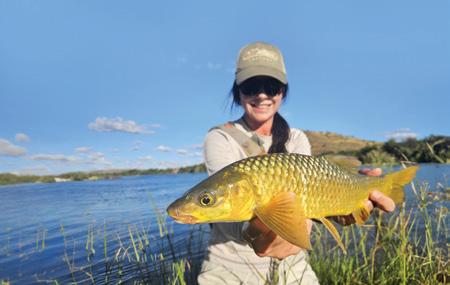

Yellowfish Orange River South Africa
+27(0) 82 477 2360 www.ngombelodge.com ngombelodge@gmail.com +27(0) 82 477 2360 Tigerfishing Barotseland Zambia
www.gkhuigkhui.com info@gkhuigkhui.com
“THERE’S NO SKATE TRICK THAT I TRIED FOR AS MANY HOURS AS I DID TRYING TO CATCH A WINTER STEELHEAD. THAT TOOK EIGHT MONTHS, MOSTLY BECAUSE I WAS FISHING THE WRONG RIVER.”





EDITOR
Tudor Caradoc-Davies
ART DIRECTOR
Brendan Body
EDITOR AT LARGE Conrad Botes
CONTACT THE MISSION
The Mission Fly Fishing Magazine for Soutie Press (Pty) Ltd 25 Firth Road, Rondebosch, 7700, Cape Town, South Africa info@themissionflymag.com www.themissionflymag.com
CONTENT COORDINATOR Matt Kennedy
COPY EDITOR
Gillian Caradoc-Davies
MANAGING DIRECTOR
Ingrid Sinclair
ADVERTISING SALES tudor@themissionflymag.com
CONTRIBUTORS #45
David Gravette, Rob Scott, Conrad Botes, Matt Kennedy, Dr Bronwyn Egan, Pete Schulenberg, Dr Hlulani Archiebold Hlungwani, Jako Lucas, Nick Wood, Myburgh van Zijl, Shaun Dickson, Jimmy Eagleton, LeRoy Botha, Samuel Fretwell, Ed Herbst
PHOTOGRAPHERS #45
David Gravette, Kade Thompson, Shaun Dickson, Conrad Botes, Samuel Fretwell, Rob Scott, LeRoy Botha, Matt Kennedy, Jako Lucas
THE MISSION IS PUBLISHED 6 TIMES A YEAR. THE MISSION WILL WELCOME CONTENT AND PHOTOS. WE WILL REVIEW THE CONTRIBUTION AND ASSESS WHETHER OR NOT IT CAN BE USED AS PRINT OR ONLINE CONTENT. THE OPINIONS EXPRESSED IN THIS MAGAZINE ARE NOT NECESSARILY THOSE OF THE MAGAZINE OR ITS OWNERS. THE MISSION IS THE COPYRIGHT OF SOUTIE PRESS (PTY) LTD. ANY DUPLICATION OF THIS MAGAZINE, FOR MEDIA OR SALE ACTIVITY, WILL RESULT IN LEGAL ACTION, AND YOUR COMPULSORY ENTRANCE INTO FLORIDAH SWAMPFEST WHERE YOU WILL BE COMPETING ON A BMX MADE OF PRISON PERMIT WHILE WEARING THE GRUNTERIST’S PISS-FILLED WADERS. @THEMISSIONFLYMAG
WWW.THEMISSIONFLYMAG.COM 14
Fish hands on deck across most of David Gravette’s skateboard artworks.



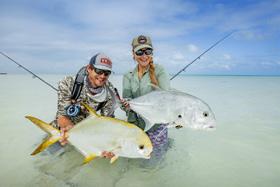




Alphonse Island | Cosmoledo Atoll | Astove Atoll | Farquhar Atoll Providence Atoll | Amirante Islands | Platte Island +248 422 9700 [GMT+4] | reservations@alphonsefishingco.com | www.alphonsefishingco.com Home of the world’s best saltwater fly fishing
CHUM
F3T IS BACK, THE LAST SALMON PODCAST, THREE NEW BOOKS, BULLY BEEF, BEAST CHEATS AND THAT DAMN CATFISH.

LISTEN TO...
...THE LAST SALMON, a cracking new podcast from award-winning podcaster Daire Whelan, co-presented with actor Jim Murray (who plays ol’ sweaty Prince Andrew in The Crown on Netflix and stars in Apple TV’s Masters of the Air) and who also happens to lead Activist Anglers. Covering the many issues plaguing wild Atlantic salmon stocks, Season 1 features 12 episodes with guests ranging from scientists to anglers and activists and include cloutcarrying names like Yvon Chouinard, Mikael Frödin, Jasper Pääkkönen and Paul Whitehouse. You can find it on Spotify, YouTube or Apple Podcasts.
“12 EPISODES WITH GUESTS RANGING FROM SCIENTISTS TO ANGLERS AND ACTIVISTS.”

GET YOUR TICKETS FOR...
...THE FLY FISHING FILM TOUR. F3T is back in SA with a rip-snorting line-up of films and an expanded five-location calendar. The film line-ups include Seffrican filmmaker Si Kay’s permit-on-the-surface film, What Lies Above, Fred Campbell from Hooké’s Only The Salmon Know, Helmut Zaderer’s peacock bass film Rio de Gigantes and many more. Locations include the customary Durban (11 June), Johannesburg (12 June) and Cape Town (13 June) shows plus screenings on the Garden Route (Knysna on 29 May) and Fothergill Island (Lake Kariba, Zimbabwe). As usual there will be plenty of clobber worth diving across three rows of seats for. Find out more about the films at flyfilmtour.com, get your DBN, JHB and CT tickets at quicket.co.za and your Knysna tickets at adventureonfly.co.za

WWW.THEMISSIONFLYMAG.COM 16

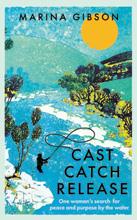
THE BELIEVER - DAVID COGGINS
David Coggins, the author of the outstanding The Optimist, is back with a new book. In The Believer, he’s even more relatable as he gets to grips with both the general passing of time and what that means for his fishing (especially when it comes to relationships, something that most of us contend with). There’s a sense as he embarks on trips to seven far-flung destinations – Norway, Scotland, Spain, Cuba, Argentina and three US destinations in Wyoming, Tennessee and the Catskills – that he is bidding farewell to the angler he was as a younger man and embracing the wiser, older version of himself, a character no less obsessed with the fish at hand. Funny, poignant and relatable, David is a writer to treasure and The Believer should be high on your to-read list. simonandschuster.com
“FUNNY, POIGNANT AND RELATABLE, DAVID IS A WRITER TO TREASURE AND THE BELIEVER SHOULD BE HIGH ON YOUR TO-READ LIST.”
CAST CATCH RELEASE
- MARINA GIBSON
Like when celeb footballers release their memoirs while still in their 20s, it might seem a little early for trailblazing angler Marina Gibson to drop Cast Catch Release, her memoir of life thus far, but with a talent for storytelling and a well of experience to draw from, Marina’s not short of material. Deeply personal, Cast Catch Release is not an Instagram highlights reel of a life well fished, but rather a first-person biopic. From her wonder at the natural world as a child to being taught to fish by her mother and exploring Scotland’s salmon fisheries and English chalk streams, in many ways Marina’s story mirrors that of the improbable journey of the Atlantic salmon, a metaphor that runs throughout the book. Irrepressibly drawn to fly fishing, despite various setbacks (her parents’ separation, a directionless party period in London, a failed marriage, etc.) like the salmon Marina found she kept coming back to the sport that provides her with both the solace and the salve, the calm and thrill she needed. The rest is history. hodder.co.uk

BITTEN HARD - JONATHAN BOULTON
Jonathan Boulton, the founder and owner of Mavungana Flyfishing, has experienced a lot in both the fly fishing and business worlds. His new book is part autobiography, part industry memoir, and part guidebook, offering a colourful collection of tales and stunning images that span half a century on the water. Having the ultimate traveling/species-accumulating fly angler Jeff Currier write the forward sets the tone for what’s to come as Boulton’s stories cover everything from record Nile perch on Lake Nasser to misadventures in the tundra, Norway, New Zealand, the USA, Seychelles and the Andamans among various other idyllic (and otherwise) locations. They also include some hard-earned pearls of wisdom on a successful travel business. The perfect read for anyone interested in fly fishing or adventure travel, it’s the kind of book that you would enjoy on a flight to the Zambezi on a tigerfish adventure, sitting down at a lodge with a beer after a day’s fishing, or relaxing at home dreaming of your next adventure. flyfishing.co.za
THE
BOOKS
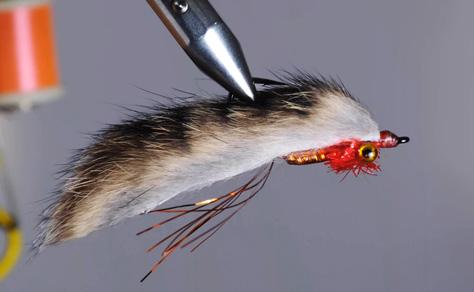
TRY OUT...
...RU HARVEY’S BEAST CHEATS. Unless you know somebody who knows somebody who can get quality XL bucktail without charging black market kidney prices, tying Beast Fleyes with average bucktail can be an issue. Enter UK-based fly tying guru Rupert Harvey’s Beast Cheats, a series of angled cones that replaces the need for a thread damn. Strong enough to tame and hold bucktail in the hollow position, yet light enough not to add weight, they work best on 60-80lb mono. rupertharveysflies.com

TYING FOR TIGERS?...
...CHECK OUT THE BULLY BEEF, Platon Trakoshis’s lethal pattern developed for the Zambezi and Okavango systems. While Platon is the first to admit that with its zonker strip this fly won’t withstand the attentions of several fish like a sparse Clouser will, with its triggers and movement, the Bully Beef is the kind of pattern that can move the needle on slow days. themissionflymag.com

“A SERIES OF ANGLED CONES THAT REPLACES THE NEED FOR A THREAD DAMN.”
THE BABER SCOPE
YOUR FISHING FUTURE ACCORDING TO YOUR STAR SIGN AS READ BY BABERMAN, THE LEGENDARY GRUMPY CATFISH.
Gemini (May 21 – June 20)
Good ol’ Geminaais, you can rely on them to come up with some fresh ideas, that’s for sure. Been skunked all day throwing turds, JAMs and crabs on the grunter flats? Out comes their “sea horse” pattern, a mishappen lump of craft fur tied to a child’s bath toy and they promptly proceed to lash the grunts. Nevermind that said pattern has never again turned a grunter on. You were there, you saw it work and now you have to live through every heroic telling of the genius fly tying and fishing tale, nodding and smiling till the day, hopefully soon, when these twins separate from their brains. Good luck.
Cancer (June 21 – July 22)
This always gets so awkward, because I am a catfish, a poesket, not some sort of wizard-Jedi no matter what The Mission would have you believe. Sure I can read currents and stuff, but your future? Nah. I just dig up old Cosmo horoscopes, blend them with a few from the Hindustan Times and add a bit of ol’ Baberman flavour. But... I am telling you that every single one of them has suggested you Cancers pleasure yourself with a vibrator this month. Their suggestion, not mine. Something about mercury in retrograde and saving yourself from embarrassment because your actual urge will be to lunge crotchward at a friend. So ja, maybe it meant the vibration coming through your fly line when a witvis nibbles on a hot spot nymph? Maybe you’re destined to go Brokerod Mountain on Elandspad 4? Maybe it’s all rubbish?

18 WWW.THEMISSIONFLYMAG.COM



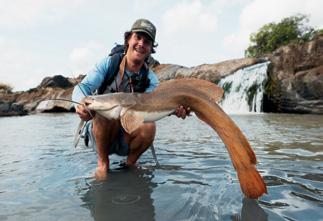


Join us at Majestic Rivers, where we redefine the fishing experience in the remote African wilderness. Tanzania’s Tanzania’s NEWEST DESTINATION WORLD-CLASS LOCATION | COMFORTABLE & PICTURESQUE | OWNE D & GUIDED BY PROFESSIONALS www.majesticrivers.com Majestic Rivers is home to a newly built 158 000sqm dam and four different and untouched river sources in the world famous Nyerere National Park (formerly known as the Selous Game Reserve). Email: info@majesticrivers.com Whatsapp: +255 752 333 473 BOOK YOUR ULTIMATE FISHING TRIP TODAY! RIVER SEASON - JUL-FEB | DAM SEASON - MAY-FEB your dream destination is calling

WHAT
Known on the Gulf Coast as the prison permit or banded permit, the sheepshead seabream or sheepie (Archosargus probatocephalus) is a bit of a bastard. I still have a lot to learn about them, and some days I feel like I have no idea why the hell they even exist, but I have also learned to love them. They behave a lot like a permit/triggerfish hybrid. You have to have your shit together with your approach and presentation. And, even if you do everything right, they can still refuse the fly. Plus, if you are lucky enough to hook them, they can easily shake it free with those humanlike teeth. I actually hooked a monster last week with a client, got him right to the boat, he did one more turn, the fly was crunched and our premature celebrations turned into misery.
Sheepshead are opportunistic, feeding mostly on small crabs, shrimps and other crustaceans. A sheepie of any size is a trophy, I have landed them from 2-8lb, but they do grow up to 15lb. They remind me so much of the zebra fish (wildeperd) that we catch on the South African coastline. Apart from looking pretty goofy, I would assume those teeth help them with feeding on all the shelled critters around rocks and structure.
WHERE
They can be found all along the Gulf (and Atlantic coast) of North America. I have fished for them mainly in Texas and Louisiana, but have also seen them caught in Florida. I’ve been able to get them to eat a fly better in Louisiana, but we do get our fair share in Texas. I have seen them in all sorts of habitats, but I mainly find them around shallow oyster beds, sandy bottom flats, and jetties. Basically all kinds of structure.
PRISON PERMIT
WITH A GREAT DENTAL PLAN AND AGGRESSIVE NATURE, THE SHEEPSHEAD SEABREAM IS A TOOTHY SKILL-TESTER OF THE GULF COAST, WHERE GUIDE JAKO LUCAS (@CAPTJACKPRODUCTIONS) TURNS TO IT AS A CHALLENGING BACKUP SPECIES.
Photo. Jako Lucas
HOW
It always helps to have a skiff or kayak, to cover more water and get you to less pressured fish. They will very often hold dead still and, if you are lucky, they will tail up. Usually they see you before you see them. They will even charge you and spook off – very much like a triggerfish. So if you can see him without him seeing you, it could be worth wading closer. Then I would put the fly as close as I can, drop it to the bottom, then slowly draw the fly. If you have his attention, he will either tail over the fly or sometimes just attack. Keep slowly drawing the fly until you really feel he has the fly, because he will try to pin it down. Then hope and pray you get a good hook set with those teeth. This is a perfect-case scenario, but most of the time those fish will just piss off.
“SHEEPSHEAD WILL CHARGE YOU AND SPOOK OFF LIKE A TRIGGERFISH.”
I prefer to use a 7- or 8-weight setup with a floating line and a 12lb fluorocarbon 12’ tapered leader. I have caught sheepies on all sorts of flies, but an olive crab pattern, heavily weighted, has been the best for me.
WHO
There are some amazing guides in Texas and Louisiana who can get you onto these fish. I do love to guide for sheepies, but they are usually a bonus while targeting redfish. Most of the guides I know will be happy to help you with places to fish DIY for sheepies. May the force be with you. captjackproductions.com
20 WWW.THEMISSIONFLYMAG.COM
LIST FISH
WISH


GEAR UP FOR PRIME SEASON ON THE CHOBE
Book your all-inclusive fishing adventure at Iching o Chobe River Lodge. Wake up, gear up and hop into your boat with your expert guide, exploring Chobe's wate rways for the best fishing spots. With a fully equi pped boat and the chance to catch a trophy tigerfish, it 's the ultimate African freshwater fishing experien ce.



+27 21 715 2412 | enquiry@zqcollection.com | ichingochoberiverlodge.com
TROUBLED WATERS
THE BROEDERSTROOM
THIS SMALL MONTANE STREAM THAT FLOWS DOWN THE ESCARPMENT VALLEYS OF SOUTH AFRICA’S LIMPOPO PROVINCE, EVENTUALLY JOINING THE LETABA RIVER, IS IN THE DWANG. SILT FROM LARGE-SCALE FARMING OPERATIONS IS THREATENING THE WATER QUALITY AND THE LOCAL TROUT POPULATION.
Words. Matt Kennedy
Photo. Kade Thompson
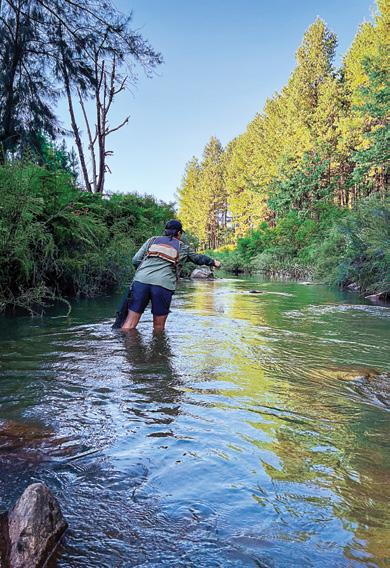
THE WATERS
The Broederstroom is home to self-sustaining populations of brown and rainbow trout. It’s one of Limpopo’s fly fishing gems, managed by the Haenertsburg Trout Association (htatrout.co.za). It rises in the Woodbush Forest Reserve in Magoebaskloof, at which point it is clean and cushioned by an excellent riparian zone of mature indigenous forest. After weaving under old lichen-covered trees and through small patches of native grassland, the Broederstroom’s margins become lined by plantations, and more recently established avocado, kiwi and blueberry crops. It’s in these areas that the vegetation composition of the river has been drastically altered.
THE WORRY
Season after season, the Broederstroom suffers severe siltation – when sand or soil blocks its natural flow – mainly caused by agricultural run-off in the river’s catchment, but also by the lack of functional riverbank vegetation. “An intact natural riparian zone ensures the good health of a river’s system by filtering pollutants, preventing runoff and siltation, and mitigating flood damage,” says Dr Bronwyn Egan, a biologist at the Larry Leach Herbarium at Limpopo University. “Legislation exists to ensure that some land converted from forestry should be restored to natural vegetation. This conversion would mitigate some of the possible deleterious effects of commercial orchards as well as silviculture practices in the catchment.”
As part of his research for a master’s degree, Dr Hlulani Hlungwani, who now works as an environmental officer at the Department of Forestry, Fisheries and the Environment found that Broederstroom trout are confined to higher-altitude sites because downstream habitats are uninhabitable as a result of land-use activities that disturb top soil. This causes the accumulation of silt and results in poor-quality static water in the lower reaches.
WWW.THEMISSIONFLYMAG.COM 22
Luke Fairhead (angler) and Kade Thompson (photographer) explore the middle reaches of the Broederstroom, near to Haenertsburg village.
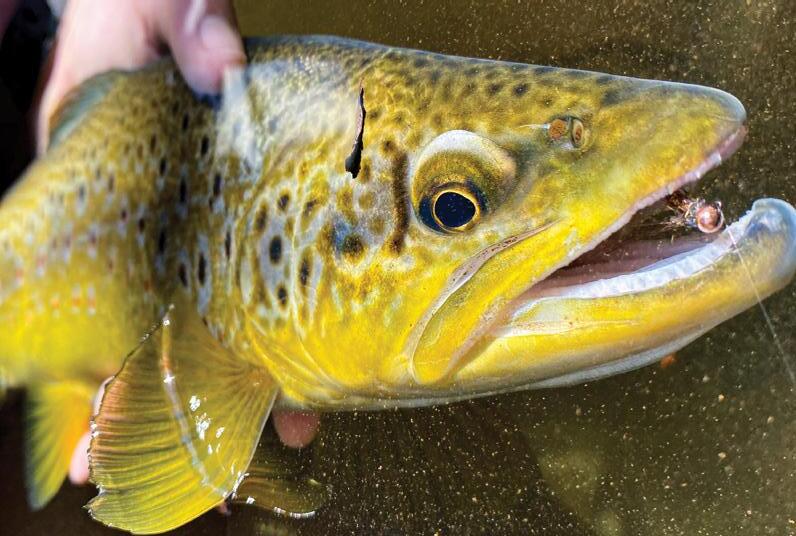
Pete Schulenberg, a concerned land owner and fly angler, has witnessed these negative effects on his local fishery. He says, “Over all the years that we have lived on the mountain, our river has been gin clear. Since 2015 or so, large farming companies started cultivating avos. Since then, there has been serious run-off and pollution flowing into the river causing a silt-up. I’m in the lower parts of the catchment, below Dap Naudé Dam, and I get all the silt.”
Pete has seen a gradual decline in trout numbers over the years on his stretch of river. Trout have a sensitive gill and oxygenation system which is easily clogged up by suspended sediment, a prominent cause of mortality. The lack of clean gravel beds in the lower Broederstroom could also be interrupting successful spawning events. Pete says, “I always stock my river at the beginning of winter. The fish last up until the first rains and then the numbers dwindle. Upstream, the river has less silt and the fishing is immaculate. Here, it used to take about a week to clear, but this brown water can last nearly a full season now.”
It’s not just the trout. Dr Hlungwani’s findings also suggest that populations of elusive mountain catfish (Amphilius spp.) are at risk.
THE WAY FORWARD
Unfortunately, no formal scientific studies have yet exposed the effects of these environmental changes on the quality of the water, and amount of water available, in the Broederstroom. Dr Egan has some ideas about how to shift the conservation.* “The existing riparian zone should be conserved where it is in a natural state, and in areas which are overgrown by alien plants, natural vegetation should be restored to create a buffer zone. If the riparian corridors are restored to create adequate buffer zones (20 to 50m wide) and the land use within the catchment above the Broederstroom is sustainably managed, then the water quality will be maintained, promoting the successful ecological functioning of the system.”
Whether the causes are land use, conservation mismanagement, or a lack of scientific research, without pressure from civil society the Broederstroom’s degradation will probably continue. Mountain Environmental Watch is one such civil group working to protect water quality and quantity in the Upper Letaba catchment. If you would like to get involved email them at mew@haenertsburg.co.za
*While river legislation does require the maintenance of a good riparian buffer, the specifics of it are vague and unpoliced. Perhaps it’s up to private land owners to pull finger and prioritise riverine health?
The calibre of brown trout found in this small mountain stream.
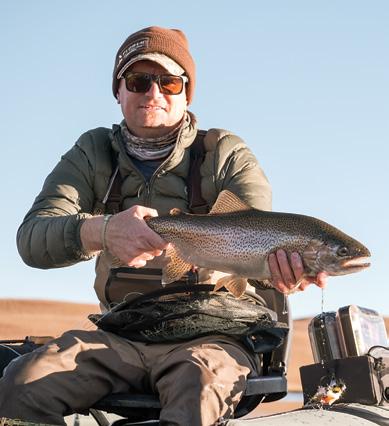
5 best things about where you fish?
1. Meeting amazing people! The hospitality of some folks towards fellow fly fishers, and the support from local businesses when visiting areas, is crazy. It’s also amazing the intel you can find out at the local pub.
2. The solitude… Nothing like the peace and quiet of the Drakensberg.
3. What’s on the end of the line of the next cast.
4. Local is lekker. Although some of our national parks are not in great shape in terms of infrastructure, most of the beaches and rivers are still mint – don’t write them off.
5. Spending time with clients on and off the water. No matter their field of work, fly fishing evens the playing fields and you can make awesome, long-lasting friendships.
5 fishing-connected items you don’t leave home without before making a mission?
1. My lucky but very tired Xplorer Fly Fishing cap that’s still not ready for a replacement.
2. Tonic sunnies – you have to protect the peepers.
3. Loon Trout Pliers – the best ever.
4. Bio Rehydrate tabs.
5. Umpqua Overlook chest pack. It’s awesome.
5 musicians/bands to listen to while on a road trip?
1. Johnny Clegg.
2. Paul van Dyk.
3. Jim Yosef.
4. Linkin Park.
5. Black Mamba Man – to make you smile.
SHAUN DICKSON
WHEN HE’S NOT RUNNING FLY TYING CLINICS OR DEMOS AROUND THE COUNTRY, YOU’RE LIKELY TO FIND XPLORER FLY FISHING’S SHAUN DICKSON DEEP IN THE MOUNTAINS OF HIS NATIVE DRAKENSBERG. THAT’S IF YOU CAN ACTUALLY LOCATE HIM, AS HIS PHONE WILL BE OFF.
5 things you’re loving right now?
1. Bikejoring with my German shorthaired pointer; she really has some pace.
2. Squash with my eldest daughter.
3. Frontier – the series.
4. Corona Extra with a slice of lime on a summer’s day. Yes I know it’s not a real beer.
5. Solar - no more load shedding. Welcome to South Africa.
5 indispensable flies for saltwater?
1. Clouser – olive over white.
2. Arctic Fox Clouser – pink over white.
3. Black/purple Semper.
4. Mylar Surf Candys.
5. Gotchas.
5 indispensable flies for freshwater?
1. Ice Minnow.
2. Elk Hair/CDC caddis.
3. Skinny Leeches.
4. Blobs – yes, I know they are filthy.
5. Zebra Midge Perdigon.
5 favourite fly fishing destinations across Africa?
1. I tend to fish local waters. We have more water on our doorstep than time available – local is lekker
2. EC - the land of giant troots and awesome river fishing.
3. Lesotho - you can’t love trout fishing and not love Lesotho.
4. Northern Zululand coastline – the species list is endless.
5. Zimbabwe and Mozambique.
“I TEND TO FISH LOCAL WATERS. WE HAVE MORE WATER ON OUR DOORSTEP THAN TIME AVAILABLE - LOCAL IS LEKKER.”
HIGH FIVES
24 WWW.THEMISSIONFLYMAG.COM
Photos. Matt Gorlei, Marc Boreham
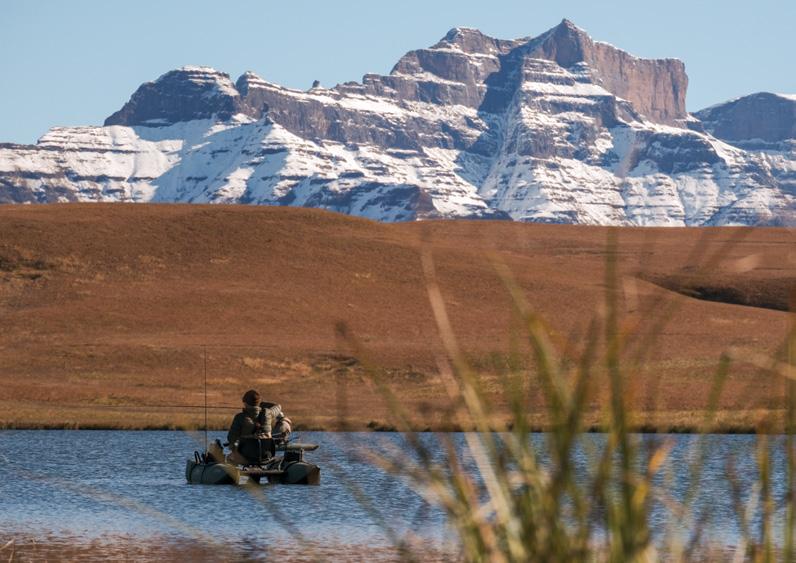
5 of the most difficult guiding experiences so far?
1. Trying to get first-time float tube users out and fishing is easier said than done when you have two left feet.
2. A whip finish to a leftie! But, in all seriousness, for beginners it can be a mess until the switch flicks on.
3. Everything is planned and sorted, then, when you’re on the water, a massive Drakensberg rage storm pops out of nowhere and floods you out.
4. Keeping new anglers upright in flowing mountain rivers.
5. Spinning deer hair.
5 of the best things you’ve picked up from your job?
1. Appreciate what you’re good at. What you are able do without thinking is not always the case for others who pursue this amazing sport.
2. The exposure you get working in the fly fishing industry in terms of innovations from around the world, whether it be the latest gimmick or next-level gear. I’m always amazed at the sport’s progression.
3. We are always on about the fishing but, at the other end, my passion is fly tying. It really gets the creative juices going. I’m fortunate to be on the Semperfli Pro Staff Team
and the constant exposure to new materials as well as amazing tyers from all over the world gets me tying new patterns and constantly coming up with new ideas. Most times I will finish tying, walk out and then be back in about five minutes to tweak the pattern I’ve just tied.
4. The reactions of anglers to either their first fish or a PB is priceless.
5. Be humble – fish don’t care who you are. They will make you look like a fool in a flash.
5 of the worst things you have picked up from your job?
1. Foot rot – wading boots worn for days on end can be an amazing habitat for the growth of some funky stuff.
2. Burnt wingnuts – fighting the sun is a struggle.
3. Farm drinks – whiskey and unpasteurised milk on ice still gets consumed (with a struggle) every season. It’s quite lekker, but better with chocolate milk.
4. Winter hands – if you have a quick look you could confuse mine with a leguaan’s foot.
5. Although working in the fly fishing industry is awesome, getting stuck behind the desk when the fishing is firing is never great. (I suppose it has to be done.)
Perks of the job - Highmoor in the Maloti-Drakensberg Park is one of Shaun Dickson’s offices.
5 flies to pack (in the smuggler kit under your driver’s seat) to cover most species?
1. Clouser.
2. Olive Zonker.
3. Elk & CDC caddis.
4. Charlie pearl/orange.
5. Jig style PTN. Hook/bead/pheasant tail – done.
5 people you would like to guide or fish with?
1. My old man - what a legend.
2. Flip Pallot.
3. Clark Pierce of Fly Fish Food - Uncle Cheech cracks me up.
4. Pablo Juárez Vinagre – we have fished together but I’d enjoy another trip. Awesome human.
5. Luboš Roza.
5 fish on your species hit list?
1. Tarpon.
2. Triple-digit yellowfin tuna.
3. Tusky.
4. Northern pike.
5. Sea-run brown trout.
5 shower thoughts that have occurred to you while fly fishing?
1. Would that fish still not have eaten the dry even if I’d gone down to 9x?
2. (Having been there for days on end…) I’m sure the fishing will be on fire tomorrow.
3. I wonder what’s in the next valley?
4. I should have been there earlier.
5. Trout can be d!cks.
5 of the most underrated species in your book?
1. Black bass – they’re easily accessible and love a topwater fly.
2. Carp.
3. Pickhandle barracuda – when you find them, they are brutally aggressive.
4. Rock salmon.
5. Natal scaly – they vary through the different river systems, can be picky, and are still able to drop a gear when they get upset.
5 destinations on your bucket list?
1. Southern Argentina.
2. Saskatchewan.
3. Swedish Lapland.
4. New Zealand.
5. Kenya.
5 things (outside of the fishing) that make where you fish so special?
1. The views – man, the mountains can make you feel small. This monstrosity of a feature changes dramatically through the season and has a magical draw which is unexplainable. The mountains are my happy place.
2. The proximity to home. Just a quick spurt in the van and I can be fishing top-quality waters.

3. The solitude, not surrounded by the hustle and bustle of city life (and no cell signal).
4. The species available in just one province. In KZN you can literally catch a GT in the morning and a brown trout in the afternoon.
5. Landowners – there are some amazing people who give us access to their properties to fish. They don’t have to, but they do. Respect the landowners’ wishes and you can have some epic times.
5 things you would take up if you weren’t always fishing?
1. Spend more time with my girls – my wife and kids are amazingly supportive of my fishing career.
2. Traditional archery – I dabble in it now, but you need to have time to dedicate to this sport.
3. Adventure biking – so many places to go and explore.
4. Have a sleep in or two.
5. Bush walking.
5 essential ingredients for an incredible mission?
1. Mates - without the characters that you call mates by your side, the mission wouldn’t be complete.
2. No matter what the pack weight is, you have to fit in the OBs (Old Brown Sherry) for that sundowner sesh.
3. Back Country Cuisine’s Chicken Tikka Masala freezedried meal. It’s the best with no jumping the queue side effects.
4. TP - the real white gold.
5. Backup box of smokes - you never know what may happen.
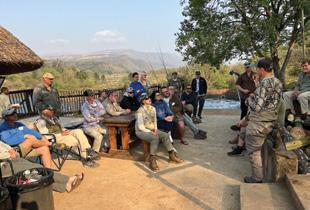
WWW.THEMISSIONFLYMAG.COM 26


“BE HUMBLE – FISH DON’T CARE WHO YOU ARE. THEY WILL MAKE YOU LOOK LIKE A FOOL IN A FLASH.”
5 flies that to look at make no sense but that catch fish all the time?
1. Blob.
2. Fluoro Pink Squirmy.
3. NYAP.
4. Speedcop.
5. Lexi Fly.
5 things about fly fishing that you may never understand?
1. That happy hour - why?
2. The dislike of competitive anglers in South Africa. Competitive angling has played a huge role in the development of new gear and techniques to improve catch rates worldwide. Most of the guys I know are more than happy to assist anyone who fly fishes, beginner or not.
3. Why people want to skimp on fly lines, some of the most important items you need. Different lines for different times.
4. The Squirmy.
5. Social media keyboard warriors, always on the chirp looking for another few followers instead of just going fishing.
5 common mistakes that most clients make?
1. Not understanding the species they are targeting.
2. The tackle bought for name or price and not for function.
3. General fitness - back-to-back days fishing can be brutal.
4. Forgetting that, sometimes, it’s not all about the fish but the entirety of the trip, the ups and downs, the laughs and tears and, hopefully, a good fish to top it off.
5. Tackle and gear preparation.
Your last five casts were to… Brown trout on the Mooi River. It’s such an epic river with mixed sections available around every bend.
28 WWW.THEMISSIONFLYMAG.COM

Photo. Gabriel Botha

UNDERCURRENTS
BEN’S DAM
LIVING IN THE CAPE (WHERE SMALLMOUTH BASS ARE A GUILTY AND FURTIVE PLEASURE) CONRAD BOTES OFFERS UP HIS KUIER KIDNEYS IN EXCHANGE FOR A SHOT AT SMALLIE HEAVEN.
Photos. Conrad Botes, MC Coetzer
Legend has it that Lefty Kreh was once asked, “If you had to choose only one species to target on fly for the rest of your life, what would it be?”
His answer: Micropterus dolomieu. Smallmouth bass.
I like to think the greatest modern fly angler knew what he was talking about. However, when I started fly fishing in the Western Cape years ago, I quickly realised that not everyone saw smallies the same way. In fact, they were either ignored or despised by most local fly fishers. The Cape streams’ trout brigade hated them and all of them encouraged me to “chuck them on the bank” whenever smallies entered the conversation. The Clanwilliam yellowfish and indigenous species crew hated them even more. I could see the latter group’s point (smallies nail indigenous cyprinids), but not that of the trout snobs. The bigotry involved in killing an invasive fish to protect another invasive species was beyond me. And then, to top it off, members of both these groups would proudly post pics on social media of trophy largemouth bass. As if that was different. I don’t know why, but I have very little love for largemouth bass. Give me smallies, their swift water habitat and their badass attitudes.
With my love for these fish, I felt like such an outlier in the fly fishing scene. On the flip side I also thought of myself as the country’s more fervent smallmouth-bass-onfly disciple. A tribe of one. Despite the fact that nowadays I spend most of my time fishing in the brine, smallies will always hold a sweet spot in my heart and a dedicated slot in my fishing calendar. If I can find them.
When I started pursuing them, there used to be a wealth of options to choose from. Breede River, Brandvlei Dam and, of course, Clanwilliam Dam. Sadly, many of these fisheries have deteriorated as smallmouth waters, mostly
because of the introduction of sharptooth catfish (another debate, as these poeskets are indigenous to South Africa yet alien to the Western Cape). I noticed the deterioration of the smallmouth bass fishing most at Clanwilliam Dam, a spot renowned for plenty of trophy-size 20-inchers. While the disappearance of the smallies was good news for Clannies, I couldn’t help feeling a growing emptiness in my fishing calendar. It was getting harder and harder to find smallies and I was really starting to miss them.
Around the Covid period friends started telling stories about this crazy guy in the Swartland who had several dams stocked with smallies on his farm. There was apparently one dam, bigger than the others, that was the stuff of legend. Ben’s Dam. The nutter in question, Ben, is a protea farmer, who fishes for everything from smallies on fly to bronze whalers on stand-up gear (he’s a West Coast rock and surf guy), plus everything in between. I had no idea what it was about the area that made the fishing so good at Ben’s Dam but from the whispered feedback I was getting, it was no normal dam. It was reputed to be hands-down, no-contest, “The best smallmouth bass dam in the country.” I needed to meet this man and fish with him.
I soon realised that it’s easier getting an invitation to join the Illuminati or the Ceres trout syndicate, than get one from Ben. I made enquiries of the lucky friends who had cracked the nod before, but it seemed they were in the same boat as me – hopeful, somewhat anxious and fizzing like kids before Christmas on the off-chance Father Christmas pitched. You see, no one knows what triggers an invite from Ben. It could have something to do with harvest times, Dutch flower stocks, the direction of the wind in the Swartland, or the man’s seasonal smallieaddled fever dreams. All I knew was that if an invitation ever came, I would be there in no time.
“IT’S EASIER GETTING AN INVITATION TO JOIN THE ILLUMINATI OR THE CERES TROUT SYNDICATE, THAN GET ONE FROM BEN.”
WWW.THEMISSIONFLYMAG.COM 31
One bright day, somewhat miraculously, my ticket came through. Feeling like lottery winners, MC Coetzer and I found ourselves driving through the canola fields heading north through the Swartland. Destination: Ben’s Dam, where our mate chef PJ Vadas was to join us for a weekend’s fishing with Ben.
When we arrived at his place on the Friday afternoon, Ben was busy at his warehouse, wrapping up a week’s work and putting hundreds of proteas into cold storage. They were to be shipped off to some fancy duchess’s dinner table in Sussex on Monday morning.
“Awhê my masekinners! Befok! Kom ons gaan gooi nat!” was Ben’s hello. The last part could be interpreted as “Let’s go fish.” Could
After a quick beer or two, we hopped into Ben’s double cab bakkie and shot off down some obscure dirt road to one of the closer dams. This was not Ben’s Dam, but a more accessible taster. By way of explanation, he said, “I want to BRAAI [BBQ/asado] manne, and don’t want to waste kuier [chillaxing] time and drive too far.”
As the sun went down over the dam and I released yet another solid smallie, a feeling of happiness and excitement for the fishing we were to do the next day came over me. If this farm truly was the smallmouth heaven I believed it just might be, I was at the pearly gates checking my shoes in.
Soon after we arrived at Ben’s house, we were greeted by his wife Suzy and two kids. Ben lit a fire in a big fireplace right in the middle of the kitchen, Suzy and the kids said goodnight and disappeared upstairs. As Ben tossed a full streepsak of wood on the already roaring fire, I wondered why Suzy was not joining for the braai. The answer to that would become apparent over the next 36 hours or so.
“Nou gaan ons braai!” came the rallying cry from Ben, who was clearly just as excited about the kuier as we were about the smallies.
Never one to need his arm twisted, I thought, “OK, let’s go!” and poured another beer. The evening was quickly gaining velocity and soon everyone was talking loudly at the same time, discussing smallies and preaching to fellow members of the choir about why they were so fucking awesome. Brandy soon replaced beer and wine.
It always felt like we were about to flatten out the coals and braai but then more wood would be thrown onto the fireplace. Eventually PJ noticed that I had eaten half of one of the sourdough loaves he brought for braai broodjies, and it dawned on him that everyone must be starving.
“It’s getting late Ben, let’s braai. The coals are ready,” PJ said as he tried to spread the coals in front of a furnace that
“IF THIS FARM TRULY WAS THE SMALLMOUTH HEAVEN I BELIEVED IT JUST MIGHT BE, I WAS AT THE PEARLY GATES CHECKING MY SHOES IN.”

was hot enough to melt half a ton of bronze. Now if there’s anyone that should know if it’s time to braai, it would be PJ, celebrated chef and owner of Vadas Smokehouse. “Nooit my bra! That’s not enough coals,” Ben screamed as he tossed yet another streepsak on.
By this stage I’d figured out that Ben is probably one of the most eccentric people I’ve ever come across. Apart from being a highly skilled botanist, I also discovered then that he’s an excellent musician. Next to the kitchen was an enormous living room with a band stage in the one corner. It appeared that Ben played everything from the drums to bass and harmonica and whichever guitar he picked up. Soon Ben was sitting on a bar chair in front of the roaring fire like Satan, while we, his doomed disciples, listened to him playing Metallica in a room that felt hotter than Hades.
WWW.THEMISSIONFLYMAG.COM 32

After that, the night became blurry. I don’t recall a lot, but I do remember (in no particular order) that:
1) I fell off my chair twice.
2) I fell asleep on the toilet three times.
3) I smashed a glass on the table while head banging.
4) I almost fell into the massive fire.
5) I got amorous on the dance floor with Barney, Ben’s daughter’s purple dinosaur stuffed animal.
MC woke me up before sunrise; it was time to go fishing. A growling stomach told me that I hadn’t eat any of the braaivleis, which PJ apparently finally got to serve at 2am. When I got to the kitchen, the fire was already going and so was the smallmouth banter, albeit a few decibels lower than whenever my memory checked out the night before. We inhaled coffee and rusks, and then moered everything into Ben’s bakkie and hit the dirt road for the bigger dam, down the valley. THE dam, Ben’s Dam.
Ben’s place is situated on an elevation where the weather is perfect for proteas, and he refers to it as bo-berg (upper mountain). “Moenie worry nie massekinners, we’ll be there
soon,” Ben said over his shoulder as he hit the gas. Ben obviously knew the road very well, because he was looking at everyone and everything except the road in front of him. With metal blazing over the car stereo, Ben raced the bakkie down the mountain’s dirt road, as the rest of us wondered when exactly we would reach our inevitable, imminent deaths.
Eventually the bakkie hammered to an abrupt standstill, amid a collective wince of aching heads and queasy stomachs. Despite the great deal of enthusiasm coursing through us to rig up quickly, there wasn’t a lot of speed involved.
“Motherfucker!” MC cried out as he sat down in a thorn bush to lace up his wading boots. PJ disappeared into some bushes as nature beckoned while I stuffed around searching in my bag and then the bakkie for my sunglasses. Ben made the first cast followed by MC and PJ. I was on the water last [Ed: Highly unusual for Conrad] because it transpired that I’d left my sunnies at the farmhouse. As I tied on a fat Zonker pattern, the first whoops and “fuck yeahs” were already echoing across the dam.
Our copy editor asked for an informative caption here, but we can’t disclose the location of where this smallmouth bass was caught.


“IT
FELT LIKE THERE WAS A BUCKET OF SLOP WITH NEEDLES FLOATING IN IT
WHERE MY BRAIN USED TO BE.”

Ready as I could be in my hungover state I walked down to the water and tried to identify some smallmouth structure. The sun was scouring me, reflecting off the water at a relentless angle, penetrating my retinas and drilling laser beams into the back of my skull. It felt like there was a bucket of slop with needles floating in it where my brain used to be.
Ben was fishing about 50m away from where I was laying out some casts on a floating line. I was about to recast when the line was abruptly yanked from my hands as a smallie hit the fly. As it shot off and made its first jumps, Ben came running and screaming. Soon a 20-inch smallie lay on its side in the shallows and Ben was slapping me wherever he could in search of high fives. “Jass my bra! Dis ‘n ma se kontsekind van ’n stuk vis daai!” Which roughly translates to “Dude! Nice fish!”
Soon the sun eased its angle, my brain re-appeared, and I was lost in catching one trophy smallie after another. PJ got a 22-inch smallie, which, for those who know, is really as good as it gets. MC was fishing across the dam in a deep ledge by the dam wall. I assumed that one of his fancy
Game Changers was stuck to a sunken log, because every few minutes when I looked across and spotted him, he seemed to still be trying to pull it loose. When we stopped for lunch and a beer under a massive wild fig, he told me that he had been drilling fish after fish on a topwater hair bug pattern. So every time I looked up and spotted him stuck on that log he was actually onto yet another smallie.
Ben’s Dam had all the structure one could wish for. Rubble fields, gravel beds, drop-offs and reed beds. It truly is smallmouth heaven. So when Ben suggested we take a drive around the dam to the inlet on the opposite side where there was a flat sandy area with submerged grass due to the high springtime dam level, I was reluctant to move. I hopped in the bakkie with everyone but thought Ben must be crazy. What’s this kak now? Every smallmouth angler will tell you to choose rocks, rubble and ledges over sand. Smallies don’t like sand. When we got out on the other bank, Ben urged us to watch out for mole tunnels. I eventually made it through the hundred metres of boobytrapped, mole-holed sand and stood at the water’s edge. It was shallow and sandy with sunken grass. The smallmouth angler inside me was not happy. I made a cast and started stripping the black Game Changer through the shallow grass. A few casts in and suddenly a bow wave pushed up behind the fly as a smallie charged in and moered it. Action stations! Soon everyone was into fish and we even managed a quadruple-up. I swapped the streamer for a popper and had a blast watching it getting punished. One batshit crazy fish even jumped out of the water and ate the fly on the way down.
That night, as the fire was roaring once again, I still felt a bit fragile, but also exhilarated. Like a piece of metal that’s been taken out of a furnace and left to cool down, I was glowing, still vibrating and slowly returning back to my regular state. With the tenacity of a honey badger, Ben took centre stage as he told stories, joked and played some guitar. Eventually PJ built up the courage and asked; “Ben, why the fuck won’t you let us braai, dude?”
“Nooit my bra,” came the response, “Once I’ve eaten, I don’t feel like taking a drink anymore. And you must know how much I like to kuier with you kontsekinners!”
There’s two rules when we fish at Ben’s dam. 1. Friday nights are compulsory. No one is allowed to pitch up on the Saturday morning. 2. We don’t fish on Sundays. I guess that latter can be explained by the void that not having a campfire de-brief will leave in our lives.
There was a quietness that descended upon MC and me as we rolled down the mountain that Sunday morning, heading south, back to the city. I guess we were both relieved to be going home, but also sad. Who knows when Ben will invite us again? Probably too long for anyone to remember to be cautious about the Friday night skop
35 WWW.THEMISSIONFLYMAG.COM

ALL YOU
WORDS ROB SCOTT (WITH HELP FROM NICK WOOD AND MYBURGH VAN ZIJL).

CAN EAT
EASTERN EUROPE
THE TRIPS THAT REMAIN SEARED INTO YOUR MEMORY UNTIL YOU LOSE YOUR MARBLES ARE THE ONES THAT PROVIDE CHALLENGING YET HUGELY REWARDING FISHING AND QUALITY VIBES WITH YOUR MATES. THAT’S WHAT ROB SCOTT AND HIS FRIENDS EXPERIENCED AS THEY TOURED AROUND EASTERN EUROPE.
What gives a mission that special flavour? What produces that uniquely foreign taste of adventure and exhilaration that leaves you sublimely sated, but with a little room for just one more bite? Like a delicious meal, it’s probably more than any one single thing.

For me fly fishing is the key base ingredient. Mix in a few exotic fish species, ideally in a beautiful far-off place with lovely locals and equally lovely weather. Spice it up with a wide variety of waters to target, and make it just difficult enough to fish or to access. Naturally, a good crew of tight mates is crucial. Then, sugar-coat the whole thing with a favourable exchange rate and good local beer, and the dish has prepared itself. Garnish with banter.
Good friends Nick, Cloete, Dean and I got to sample the sweet and varied spread laid out by Slovenia, Bosnia and Croatia, and gorged our way through a magnificent twoweek menu that any fly fisher would do well to savour at some point.
Table for four
The months leading up to the trip were spent sorting out bookings, tying hundreds of flies, checking and rechecking gear, poring over maps, and just generally getting restless. Everyone met up at OR Tambo International Airport in Johannesburg, quickly checked in bags, and hurried along to the Slow Lounge, eager to catch up over a few free whiskeys courtesy of FNB. Okes were excited, and the banter kicked off pretty much instantaneously.
A cramped seat and a long flight were unpleasant, but the promise of big, beautiful rivers kept our spirits high. In our largely sleep-deprived state, touchdown in Slovenia and the process of going through arrivals was a blur. A quick coffee helped, but the real wake-up was getting our rental car. This fancy flippin thing was, simply put, from the future. It barely required a driver. It braked automatically if the car ahead slowed down, violently jerked the seatbelt if you removed your hands from the wheel and, with unsettling regularity, just took over the steering. It didn’t kill us but was, among other things, the reason I was pulled over by the local constabulary 80m up a one-way street.
Starters in the capital
Before we set off to explore the rivers, we decided to spend a day in Ljubljana, the capital of Slovenia. This historic and beautiful city is overlooked by a 500-year-old castle, and we slowly took in the sights while quickly climbing into the extensive selection of local beers. Under a little peer pressure, Cloete ordered Bear Goulash from the seasonal menu, but to his bearly concealed relief they were all sold out. Fishing should probably remain the priority when visiting the area but, if you have the time, it’s absolutely worth making the effort to explore Ljubljana. As was the case for the rest of our trip, we opted for the comfort and convenience of Airbnb. It’s usually the cheapest option and allows for some engagement with the locals and the vibe.
Tolmin treats
With bags and hangovers packed into the FutureMobile® the following morning, we eagerly headed to the quaint town of Tolmin, our base for the next five days. The town is perfectly situated close to five amazing local rivers, including the legendary Soča, which was to be our first stop. Headaches were forgotten as we dumped our luggage and headed to the water’s edge. The sight of the aquamarine blue water running over a white chalk-stone riverbed entranced us to the point of just standing and staring. The spell was broken by the sound of Cloete running to the car to grab his rod. Arguably one of the prettiest rivers in the world, the Soča is home to an impressive variety of fish. Our target species included chub, grayling, brown and rainbow trout, and the mystical marble trout.

38
WWW.THEMISSIONFLYMAG.COM
 The author with a fine Soča River rainbow.
The author with a fine Soča River rainbow.

“A BIG MARBLE REQUIRES DEDICATION – YOU HAVE TO PUT IN THE TIME AND AVOID THE DISTRACTIONS OF BIG RISING RAINBOWS AND SMALLER MARBLES.”
Venturing down to a wide laminar section with a narrow channel running along the forest edge, we spotted huge rainbows rising under the tree cover. Eventually cracking the code using #20 dries with tight casts and perfect drifts, we landed several fish around the 60cm mark. It definitely wasn’t easy pickings and, only a few hours in, it was already apparent that the next two weeks would involve some very technical fishing.
The following morning, we parked at Camp Gabrje, a huge campsite on the banks of the Soča. It offers access to a beautiful piece of river strewn with big boulders, deep pools and some lovely, long rapids. Nick and I walked downstream leaving for Cloete and Dean the section upstream of the campsite. It was tough fishing, but Nick and I managed a few good rainbows and a marble of about 45cm. Regrouping for lunch, we recounted tales of our morning efforts. Dean reported an exciting moment when a huge marble had come out from under the boulder he was standing on to try to eat the rainbow he was trying to land. Cloete had an odd grin on his face and was keeping suspiciously quiet. Upon prompting he admitted that he had blanked the session, struggling to concentrate on the fishing with several topless women swimming and sun tanning in his spot. Apparently moving to a different spot hadn’t occurred to him.
Idrijca entrees
Our next taste of Eastern Europe was the Idrijca, a mysterious river obscured by the cover of mountainous Balkan mixed forest. The Idrijca is crystal clear but, unlike the white chalk of the Soča, the river bed here is decorated with a mix of stones in shades of dark green and orange, making it difficult to read and contributing to its mystical atmosphere. The fastmoving water rushes through large boulders, creating the perfect habitat for ambush hunters like marble trout. One of the largest and quite possibly the smartest trout species in the world, these fish are serious adversaries. They’re like chameleons in the water, capable of changing their colour and patterns within minutes (much like cephalopods), essentially vanishing into their environment. We were beyond determined to land one of these elusive creatures.
Hunting big marble trout is not dissimilar to targeting largemouth yellowfish. You can hike up the river blind-casting at structure and holes or, if you are lucky, spot an individual fish to target. They have excellent eyesight and generally spot you first, which is an immediate game over. It’s superfrustrating especially in the calmer water as you spook one after the next, watching them skulk off while eyeballing you from across the current. A big marble requires dedication – you have to put in the time and avoid the distractions of big rising rainbows and smaller marbles. We found it best to leave the dry fly rod in the car and to pack a 7- or 8-weight rod with a sink tip line and a bunch of weightless streamers.
Opposite page: Author Rob with a special indigenous marble trout.
Top to bottom: Cloete with a marble.
A half-digested fish that came out of a marble’s mouth. Dean with a marble taken in the Idrijca.



“IT WAS MESMERISING STANDING KNEE-DEEP IN THE MIDDLE OF A 60M-WIDE MISTY MOVING MASS OF WATER FILLED WITH HUNDREDS OF RISING GRAYLING.”
The afternoon session on day three started with a pretty demoralising tally of 9-1 to Team Marble. We were getting hits but they wouldn’t stick. Stripping fast in strong current, plus their violent attacks, made for poor odds for getting a good hook set. We later realised our technique was partly to blame as we weren’t putting enough grunt into our sets. The older fish have hard jaws and you need to put some serious weight into the strike. We had hiked quite far up a beautiful section of the river and, as the sun was slowly beginning to set, we spotted a dark shadow in a tight pocket about 7m below us. While I carefully ninja’d my way into position, Nick and our experienced guide, Gašper, kept eyes on the shape and shouted instructions from the relatively obscured safety of a bush. Every time a good presentation was ignored, the fly was changed.
It was around the eighth fly change that I lost hope that the fish would eat anything, but a big yellow streamer unexpectedly proved acceptable to the marble. The eat was so fast I wasn’t sure that it had even happened, but the chaos that erupted confirmed things. The fish very swiftly necessitated a chase down river, twice snagging me behind boulders but miraculously coming loose both times before sliding into the net. I’m semi-certain that I was crying at this stage. While removing the hook we found a 25cm-long half-digested fish lodged down her throat. These predators really don’t play when it comes to their food. The Idrijca had us captivated, and we spent most of our remaining time there exploring its intriguing waters, hoping for another encounter with this fascinating fish.
Our last day in Slovenia, seeking a river more familiar in size, we headed to the upper Bača for a quick midday session before our final Idrijca hike. It was a welcome change of pace for us. The Baca is a small, clean mountain stream under the light cover of tall forest trees. The dry fly fishing was a bit less demanding than the Soča and we got some good fish in pristine and comparably wilder surroundings. What added to our appreciation for this place is that it felt more undiscovered and a lot less pressured. European rivers get fished a lot harder than those back home. The Bača helped to remind us of the natural beauty around us, while also aiding in honing our casting skills in preparation for our next destination, a place renowned for some of the most technical dry fly fishing out there – the Ribnik in Bosnia.
A note from the chef
Arriving in Tolmin for the first time can be pretty disorientating, so it’s highly recommended to contact Gašper Jesenšek at Soca Fly for a day or two of guiding. He is a really experienced guide, fluent in English and knows which rivers are fishing well at all times. He is also always
willing to offer advice for your days of self-guided fishing that follow. You can top up on most fishing supplies at his shop in Most na Soči, and check their daily updated flow chart of all the rivers and their temperatures. Fly fishing in Europe during the summer means long days on the water, with the sun rising at 5:30am and setting at 9pm. Although the water was cold, we wet waded in Slovenia as temperatures went above 30°C most days.
Bosnia buffet
Crossing into Bosnia, reminders of the region’s past conflicts were abundant. Despite the bullet holes and bomb craters, the people there seem to just get on with it and appear to do so with unwavering spirit. Where spirit may fail, spirits are also employed, and a morning beer seems like the go-to problem-solver.
From a fishing perspective, we were in paradise. Guided by the charismatic and energetic Ado Jeginovic, we fished the Ribnik, Sana, Sanica, Korčanica and Una rivers, each one unique and challenging in its own special way. Ado elevated our fishing experience, showcasing new levels of an art he has clearly mastered. Even though he spends three-quarters of his life on the river, he still has the energy for long days, and he considers laziness to be unacceptable. His dry fly fishing is exceptional and witnessing him with a fly rod is nothing short of perfection. On the downside it leaves you feeling a bit demoralised and reconsidering whether you should ever cast in public again. For those wishing to extend their collection, Ado builds a top-quality rod, and his shop in Ključ supplies a great range of his personal top fly patterns for the area, as well as quality fly tying materials.
The Ribnik presented a host of challenges. Fed by underground springs, the water is icy cold throughout its short 8km length, so waders and long thick socks are essential. Most of the river flows in a laminar fashion with thousands of the fussiest grayling you can find anywhere. I have only experienced one other river where fly selection comes down to the correct shade of #22 emerger, that is, presuming you’re able to execute the perfect drift to get a fish’s attention in the first place. The afternoon rise was utopian, and it was mesmerising standing knee-deep in the middle of a 60m-wide misty moving mass of water filled with hundreds of rising grayling. Meditative, but frustrating. In addition to the large numbers of grayling, the Sanica and Korčanica are home to massive brown trout. Cloete, Dean and Nick managed their PBs in the same day even though the real monsters turned their noses up at our nervous presentations. We experienced some amazing afternoon hatches too, followed by a few hours of early evening dry fly bliss.
42 WWW.THEMISSIONFLYMAG.COM

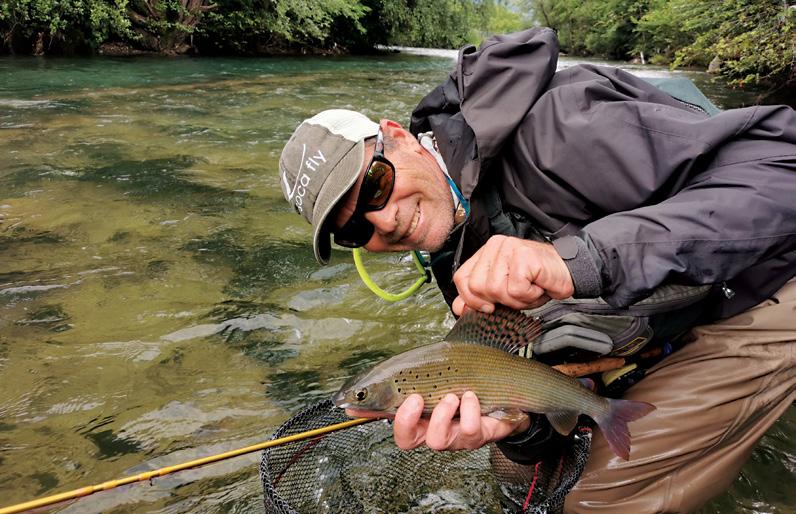


Seared Una steak
The Una carves its way through the picturesque Martin Brod National Park, home to a set of travertine waterfalls (UNESCO Natural Heritage Site status pending), approximately 130 bird species, and my shattered fishing dreams. Ado had shown us pictures of truly gigantic fish from this river, and we were salivating upon arrival. Deep and glowing green because of the colour of the rocks, the Una teems with fish. In among the shoals, we spotted the gliding shadows of what may as well have been crocodiles. Staggeringly huge fish.
With a 7wt rod and 20lb strain tippet I got into position next to a series of runs on a 30m stretch of water between bunches of trees where, in a deeper, fast section, I could see the backs of fish breaking the surface as they came up to feed. I missed the first eat but quickly landed a fish of around 5lb, which should have been prize enough, but there were even bigger ones around. I saw one for the first time coming up to check out my unweighted streamer. It turned back without committing, but on the next perfect drift it ate. I don’t think anyone, including (demonstrably) Ado, can sufficiently brief you for what happens when you hook a 10kg (yes) rainbow in fast moving water. I somehow managed to turn a brutal first run, giving me a brief glimmer of hope, but the next unstoppable surge took 100m of line, my hope, my dignity and, of course, the fish down over a series of narrow runs into a huge inaccessible pool where there was no chance of landing it. It spat the hook soon afterwards. I’m still haunted.
The sheer abundance of fish in the Una really is insane. Hundreds of good-size rainbows eager for anything you offer them gave us some respite between more technical waters. It was great fun for a change, but we packed things in before we completely pigged out and wrecked all our flies.
Of all the rivers in Bosnia, the Ribnik became our happy place. If Salmonids are your thing, I think it’s the ultimate fly fishing experience. It provided not only incredibly technical fishing that encourages you to perfect your art, but also managed to be a really easy place to unwind. Our comfy bungalow accommodation was right on the river, as was the Restoran Komuna, a small restaurant with a big heart that became our “local”. We spent many hours enjoying ice-cold beers and hearty hot meals, sharing the highs and lows of the day’s fishing.
Just des(s)erts
Plans to hunt softmouth trout near the southern Bosnian city of Mostar were curtailed when a storm blew out our target rivers. Not seeking to waste time, we shifted our bearings in the direction of Croatia. A few friendly fishermen we encountered at our local had mentioned the Gacka with great enthusiasm.
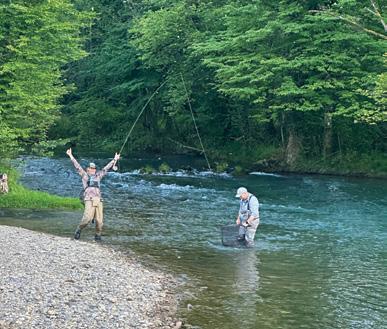
“Gacka river is best! Gacka number 1! Gacka huge fish only!”
Their descriptions were delivered with sly grins, but whether this was because the beers were flowing or because the stories were bullshit, we couldn’t be sure. Still, we went and, luckily, our suspicions of baseless fishy tales were unfounded.
The Gacka was unlike any river we had encountered before. With deep, deep, gin-clear green water and dense aquatic plant life, it was the most intimidating river I had ever approached. Because of the depth, wading wasn’t possible, so access required either pushing through a gap between reeds or finding a spot the swans use to sunbathe. Solitary big fish rose all day. To what, we absolutely can’t say. They would dart 2m to the left or right to pick up some invisible bug, but remained seemingly blind to our ever-increasing variety of flies. Although we didn’t crack any codes, we did pick up some nice browns and rainbows on tiny emergers and weightless nymphs drifted subsurface. To put the cherry on the top of a spectacular trip, the local recommendation of the Gacka proved to be ever so sweet. On our last evening we were blessed with a spectacular hatch on a river that, moments before, had seemed sparse, and fish started to boil with rises everywhere you looked. It seemed fitting, if not a little indulgent, for our last hour of fishing. The perfect dessert.
Our adventure was drawing to a close, and we couldn’t help but feel humbled and supremely satisfied by the places we had visited. From the picturesque wonderland of Slovenia to the diversity of Bosnia and the best-kept secrets of Croatia, each destination provided a unique flavour and delicious addition to the trip. If you’ve got the appetite, we strongly urge you to make a booking.
Five stars.
45 WWW.THEMISSIONFLYMAG.COM
Above: Dean celebrates catching a good brown. Opposite top: The Una River in Martin Brod National Park. Opposite bottom: Cloete with a brown out the Korcanica River.

The Grunterist And The Voices Of The Flats: A Black Comedy
WHAT DOES IT TAKE TO BECOME A GRUNTERIST? WHAT DOES IT MEAN TO BE ONE? AND IS IT A GOOD IDEA IN THE FIRST PLACE? WHAT IS A GRUNTERIST, ANYWAY? AT LEAST ONE MAN HAS WALKED THE WALK, AND IT WASN’T PRETTY. WE MAY NEVER HAVE HAD THIS CAUTIONARY TALE, WERE THE WHOLE PROCESS NOT WITNESSED BY A LUCID AND RESTLESS BYSTANDER…
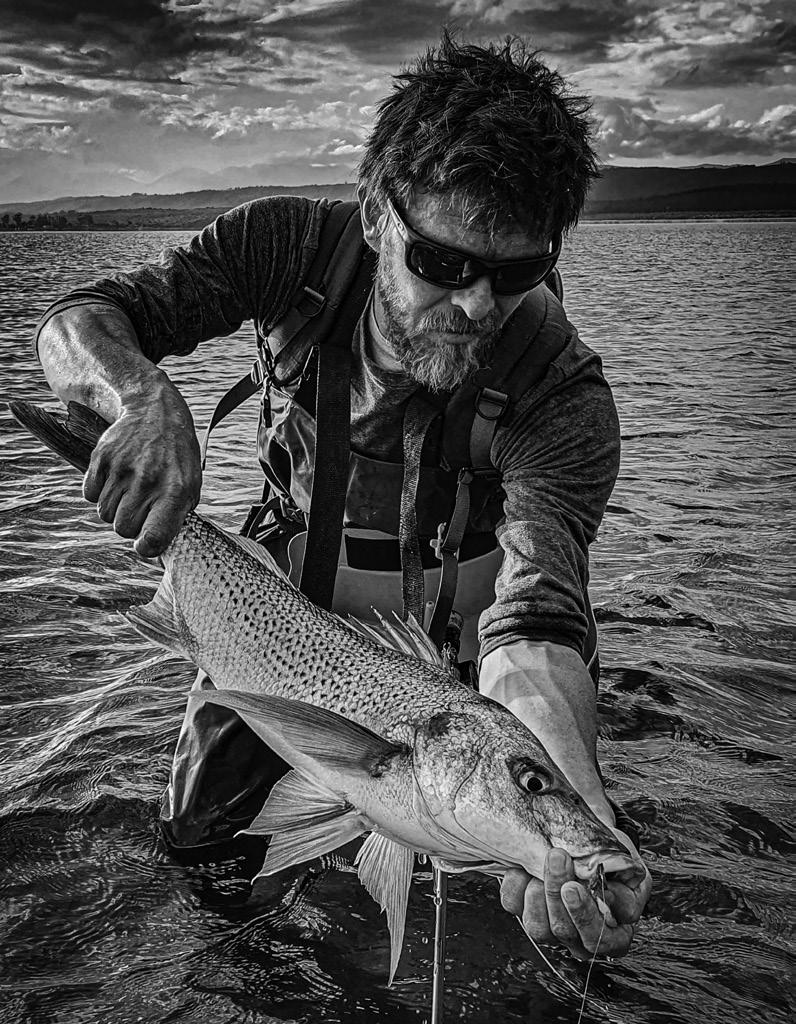
If The Original Grunterist were with us today, I think he’d want to know that we’re keeping our eyes on The River.
Oh. No. He isn’t dead. It’s just that somewhere in the early to mid-2020s, the silly fucker lost his mind.
Alive with spotted grunter and cute little coots, the vast, shallow saltwater sand flats and black marshes of the Southern Cape did something to him. Not just like “Ogh, it speaks to my soul, bru.” Something happened to him out there. It’s been said that what went down “changed him”. Some say, “He’s checked out.”
What I’m saying is that if you were wondering, this is where you find out what really went down on those flats. And if you’re thinking, “Well, that sounds ominous,” that is a reasonable instinct to have.
Gypsey’s, Clown Town, Pony Creek 1 & 2, Chanelle’s, Prawn Hub, Japan, Suburbia and Far Banks. For the grunterist, many years of solo missions were interspersed by team-ups with mates G and Joburg, and they eventually named every fishable flat on The River. It took a very long time to come to grips with the grunters that live there, but eventually it was only fair to say that they were digging it, and digging in. That’s in spite of the grunterist regularly claiming all sorts of things to the contrary. “I hate grunter,” he used to say, “almost as much as I hate fly fishing.” Back then, he was a strangely friendly underground animal thriving on neglect, with a penchant for alliteration, terrible jokes and messed up metaphors. And tangents. You weren’t supposed to believe any of it. Looking back, I don’t know why I did. And I don’t know why he didn’t know that that sort of talk comes back to bite you.
There are many fly fishing veterans who deserve sincere admiration, but I’ve become cautious of “experts”. Especially the self-confessed types, and online ones. The veterans know how unpredictable shit can get, but that experience leads to an instinct for good guesses. I respect that. They love what they do, because they’re entrenched in it. They talk about it because that’s what they talk about. Something in the way modern “experts” purvey “expertise”, however, just doesn’t sit with me. Some see them as heroes, but these days I just see monkeys in pain with smiles on their faces, hiding in coping vacuums where they get to pretend that what they’re doing matters. Call me cynical, but… wait. Enough about… that.
After a while, for a while, the grunterist became a sort of Accidental Apostle, spreading the Gospel of Grunter. Having convinced himself that he’s merely honouring the scriptures (or was it sticking to the script? Committing to the bit? I forget…) he, fatefully, shared the flies and ideas born on the flats. He preached sight-fishing and a quiet approach (inspired by the teachings of prophets like the
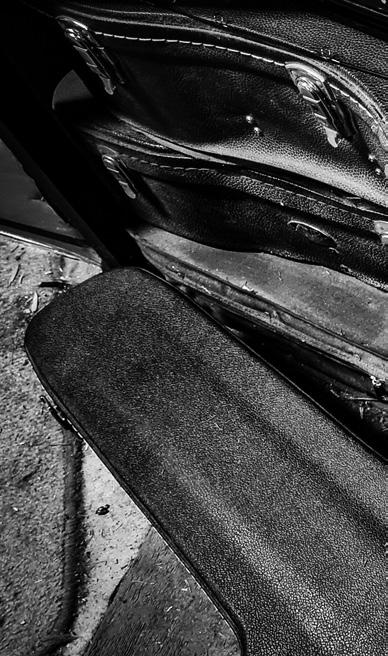
MC-iah and Jannie the Baptist) to both the fishing, and to its conservation. Although he took care not to burn his spots, he also reluctantly accepted that he’d have to eventually share the water with someone other than Joburg or G.
At this point, something unexpected happened. Let’s say I know the grunterist partially because of the following detail, partially: he’s a guitar player, and he’s entertained tens of fans for many years. He was a different guy on a bar stage. So, it came as a surprise when, upon meeting a “new dude” at The River and going fishing, the grunterist got an almighty case of the crippling stage fright. He was no stranger to the original cardiac dangers of grunter fishing, and while he got along just fine with New Dude, some damned thing rendered him free of any working muscle memory or focus, and therefore, in no way capable of fly fishing for grunter. Why? Who knows, but it showed. By the third new dude, and the third fishless day in a row,
62 WWW.THEMISSIONFLYMAG.COM 48

the frustration also showed. Hard. Somewhere around this time, the grunterist must’ve done something, or said something, because since those few days, the flats were surely cursed. Tide after tide and then month after month, the grunterist drew the blank to end all blanks. It would last two years. And although he caught one, maybe two fish further away from home, it was clear that The River had rejected him.
It was true that more and more fly fishermen started pitching up since that first time he showed the place off. But if that was the reason for his failure, it was only because he told himself so. In truth, his confidence had given way to inertia; his way with a grunter no longer required creativity. He’d become an expert. As long as he went through the motions, something had to give, right? But when that fire isn’t stoked, it burns out and when it’s out, well. Obviously, that’s when it gets cold.
There are many fly fishing veterans who deserve sincere admiration, but I’ve become cautious of “experts”.

“The clouds are rolling in, visibility will be cancelled in a minute. It’s load shedding, fly man, flats style… But… Look. Belly-crawling grunters, ankle-deep, backs out the water. All along the edges. Do you see? So you don’t have to account for viz after all. Sweet!” Cast. Strip. A hint of weight.
Sadly, from outside it appeared the only creative aspect to his approach became these weird excuses and who he’d blame next. “It’s ever since I started letting noobs onto the flats with me. Grunter on fly is a solo game and this place is getting crowded. Those pricks can’t hold it in.” Like I said. He lied to himself and let the rust set in. What was certain was that he couldn’t, in the end, see far enough out of his own mouth to recognise that losing his edge was turning him into the bad guy in the story. He’d become jealous of The Flats, and The Flats had begun to taunt him. Not really, probably, but in his head, sure, I believe it. After all, it was so well up his ass that he was blinking with his lips.
A hint of weight: “Wait. That’s what we call a weed problem, fly man. Not much you can do about that. Tsk tsk…” The Flat teased.
Thing is, even sane grunter fishermen know that, if the flats could speak, they wouldn’t send you home with a bubbly and reassuring Ozzie accent, “Aw, it’s awroight! Ya had a gowe, mate! That’s what counts!” We get that. But for the grunterist it got real personal: “Is that a lump in your throat, fly man? Have you had enough?” Imagine that sentence in whatever accent you suppose it would’ve taken to rob a man as blindly as it did him, of all but his last semblance of testicular heft. “Never give up,” he hissed. “Very well! The fly fisherman is the enemy, grunters!” he heard Them say, as a black cloud rolled overhead: And The Flat said, “He who is not with me…”
The grunterist briefly considered interjecting, “But Your Flatness, I am with you,” but his words got stuck in a clump of dry flour that had grown in his throat from sucking on pulse-slowing cigarettes, and all he got out was a choked cough. Besides, he was pretty sure his particular brand of charm was not about to do the trick.
“…IS against me! Verily, fly man, I say to you!..” The Flat shouted, stripping its gears like a spoilt little godlet, and then the clouds formed into big, bold letters across the northern horizon: “GTFO!”
62 WWW.THEMISSIONFLYMAG.COM
“I hate grunter,” he used to say, “almost as much as I hate fly fishing.”

One man’s hearing voices is another man’s intrusive thoughts, winning. Another fluffed shot, one more spooked grunter. As he watched his fly rod fly through the afternoon air, he realised that what he was doing wasn’t where it was at. They say if a person is willing to do a shit thing – like violently throwing a fly rod – once, he or she will do it again. In modern terms, a single offence absolutely points to a pattern of behaviour, right? Right then, the hate in his heart was covered by shock and shame. He’d never done such a thing before. “Don’t be a doos,” he scolded himself.
“Yeah, don’t be a doos,” The Flat clapped back.
But he couldn’t stop fishing until the wretched curse was broken. Session after session, the weather would fall apart, some fool would pump every prawn hole on the flat before he arrived, grunter would simply not show up. When they did, the result was always the same. No clean shots, bad visibility. The osprey screeches overhead and spooks them all. Usually, he appreciates birds of prey. But he hates this guy. Much like the innocent little leerfishes that keep intercepting his fly. And the schools of paranoid mullet that no one ever sees before throwing a line over
them, causing a panicked chain reaction across the entire flat. By the time a workable shot comes around, he’s so not in the zone that once again, he blows it. Once, while plying the eel grass paddies between Japan and Clown Town, he stood frozen like a heron, surrounded by feeding grunter. It had taken an hour to get into position without spooking the bastards. “Now to not, for heaven’s sake, fuck this up.” But just as he had a few feet of fly line out and his fly in his hand – as Prophet Jannie had commanded – the sky vibrated with a terrible whisper, “Make him cry, grunters!” As one, not as though they were spooked but exactly as though commanded by their unseen master, the fish calmly evacuated the flat. The grunterist gazed, gutted, as they disappeared in a slow and eerie flotilla of bow-waves. Where once was a practical man of patience and humour, now stood a crumbling, clueless clown.
Sans a resolution, he knew he would soon alienate the last few people who still tolerated his ass. He had collected all the infinity stones of blanking, and ascended to a level of desperation that was frankly hard to look at. But one afternoon, conditions looking perfect, longsuffering Joburg called for a team-up.
It was pristine. Grunter were feeding all over the flat, kicking up dust like a farmyard flock of fifty frolicking “free range” foul. The adrenaline started flowing instantly. And the frommeling began, instantly. At this point it is important to note that the grunterist knew full well to always take a leak before gearing up and wading towards Far Banks. It’s just that this time he didn’t, because the grunters were tailing and that could change any minute. And of course, not a hundred steps from shore, the two tall Americanos he smashed before heading onto the flat, wanted out. But there were shots to be had. So many shots, and so he held it until, standing auspiciously in the very middle of a vast estuary, he could hold it no more. Not only because he was holding back enough piss to claim a small country, but because holding it was making him fluff shots, left, right and up the ought. But then another grunter slinked into a textbook, super-targetable position. The grunterist buried his frustration in a deep hole of denial and tried to pinch back his pee, once more with feeling.
This was a mistake. He almost immediately knew this, of course, abandoned the whole idea of catching the fish mid-cast, and attempted with furious urgency to initiate the steps required to whip out Jacob for a bit of a holdingin-front and sheer, incomparable relief. Usually, these steps are limited to: remove stripping basket, remove backpack, release wader buckles, drop it, whip him out, let ’er rip, shake, and retrace your steps until you’ve reversed back into fishing condition. Easy. Also works best if you respond to nature’s call in time to get the hell out of the water and behind a damn bush.
However, this time, unknowingly trapped in a demonic straightjacket of his own invention, with his legs and back involuntarily seizing in panic, his knees buckling and his toes trying to stab their way out of his boots while his heels danced, unanimously unable to anchor in place, and, of course, with his bell-end blowing up like a water balloon – the steps to freedom included, but were not even limited to:
“Stripping basket. Where’s the buckle?! Get a hold of that buckle, or this whole thing is dead in the water! Backpack must be obscuring it. Fine. Pack first… Wait... What!?”
“Your sunglass strap is stuck to your backpack, fly man!”
“What in the hell?”
“Yeah. So you need to take your hat off too, or the glasses won’t come off, and then you can take the pack off. Fly man so hot right now. Fly man.”
He ripped his hat and glasses off in one go, at which point, naturally, the sunglass strap magically released the pack and the hat and glasses went flying:
“Dammit!! Whatever. Backpack. Off. Stat. Just don’t drop it in the water, too. Now it’s stuck to the damn wader belt!

64


“Hats off, fly man. That was a good show.”
What the fuck?! How?! Forget. What?! Fok! Forget it, just dig and get him out of there, now. Everything’s at stake!” But that was it. Lil penis fought the good fight but the dam broke. “NO!!!”
“HAAAAAA! You’re killing me, fly man!! Lol!”
The whole commotion, of course, would have spooked every fish in at least a 200m radius. Far in the distance, Joburg could tell that for his mate, things had gone tits up in a spectacular way. “Did he just… chuck his fly rod? ... Ripping his shirt off? What the..?” He dutifully started the very long wade to go see what’s up.
For the grunterist, The Flat’s taunting was not helping: “Well, then kill me now. I just bilaterally blew my bladder out into both wader legs and up to the brim of each bloodforsaken boot! I have warmly pissed myself, absolutely, biblically and completely, like a baby savagely missing that womb feeling, asshole!”
Standing in the middle of the estuary, naked from the balls up, bladder empty and hate rising in his belly, and with his fly rod, glasses and hat washing away, he punched a hole into the water that ripples to this day. With a racing heart and out of breath, he let out a tortured, “Motherfucker!” before bending over and puking his guts out.
It’s amazing what it takes for some people to see the light. But if he denied it or couldn’t see it earlier, he’d have to be blind to miss it now. What was once an addictive adrenaline rush for a young dude, had morphed through a stage of therapeutic necessity and into nothing short of a definite mental and physical health risk. For a somewhat less young dude. We’re talking heart attacks here, man. His desperation to break the curse had become a sick obsession, and in this moment, he reached the edge. He explained to a bemused Joburg what had happened, omitting the vomit part, and, bitter, wept inside as they laughed their asses off. Because pissing yourself is hilarious as balls.
“So, if you’d already pissed yourself, why’d you still, you know, take him out and lose the shirt?”
“Bro. Show ain’t over ’til the fatty sings. I ashed a cigarette on my head, too.”
“What?”
“You know what, Job? If I have to explain it...” he managed a friendly wink.
Joburg turned his eyes to the sky and pointed at the grunterist, smiling, “This guy?”
66 WWW.THEMISSIONFLYMAG.COM
“Hats off, fly man. That was a good show,” The Flat whispered. And then, he stopped.
He stopped fishing for grunter, he stopped talking about it. Eventually, he stopped thinking about it.
Months later, he was in the familiar flow of writing or attempting to learn a new piece of music which, were he to master it, would amount to a small personal victory. He put in a full day of apparently fruitless practice trying to get it down. Try after try, he just couldn’t lick it. Skill issues. Wheelhouse. Eventually, trusting the process, he put the guitar down, hit the sack and then went to bed. The next morning, he got up, had a coffee, and picked up the guitar. As though it had all clicked in his dreams, he played the piece effortlessly and almost flawlessly. I’m not saying it was Mozart, but it went hard, G.*
In that moment, he wondered a thing. Why did this piece of music take him back to that time on the flats, where the agony of discovery (or is it the discovery of agony?) lasts so much longer? Surely a much longer hiatus would be required to unfuck a vibe this utterly fucked and restart the hell out of a dying inner fire? A familiar grunter flat is no new song. It’s a gig you’ve played a hundred times, to a crowd with perfect pitch. Ergo, one could say, the punishment for missing a note is, rightfully, a whole lot more sadistic.
But the show must go on. And so, you learn to love the punishment. You fail. You feel it. You let it out. You rest. But you never, ever give up. He returned to The River once more, and caught a mighty grunter in no time. Time, on the face of it, was all it took. He can still be seen there from time to time, every now and again with a fly rod bent to the grip, punching the air like a victorious ninja fool. Sometimes Joburg joins him, and when he can, so does G. Sometimes it’s someone new.
I know what you’re thinking. “Well, that’s not so bad, is it?” or, “Sounds like it all worked out in the end!” Right?
The thing is, he may look like he’s got his shit back together. Hell, they say he never takes a half-ass shot, and rarely fishes the same pattern twice. I even ran into him on The River one day not too long ago. I was perplexed to see him throw a familiar little fly, apparently blindly, into the deep water just off Chanelle’s. “Fishing blind, Old Man? Really?” I asked.
“First time I’m trying this, actually,” he said with a hint of a smile, “The Flats have been good.”
“What are you after, then?”
“Mermaids.” Dead serious, he glared into the water. Right then, in a twist only mildly shocking to the both of us, he hooked and landed a fat grunter.
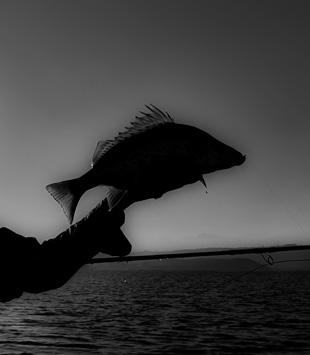
“Not really here for these,” he said. I mean, no one in the known universe could see that coming. There was a time such words would be totally unimaginable. About witnessing the beginnings of the commercialisation of fly fishing on The River, he simply said, “I hope they get it. I hope they only ever love The River.”
But you can’t fool me. He’s still boiling inside. Under all this renewed namaste demeanour, I guarantee you: every grunter he sees still spikes his heart rate so fucking hard, it’s amazing he survives a single encounter. His casts may fly true again and his flies may land softly, and every so often he catches a fish. But the scars from those dark seasons run deep. I can tell. Such blatant sadomasochism is not the work of a sane man. And can the hate he once felt truly be gone? For on that one day, he had pissed himself for these fish. If he loves grunter, he sure won’t ever trust them again. He has to be who he is in this world now. Apparently, he’s still looking for a 70cm fish, but he’ll take a 69.
*It was Strauss, obviously. Incidentally, when the grunterist hooked up with the curse-breaking grunter, he was stripping his fly in time to the melody of the first movement of the “Blue Danube”, an earworm he’d hosted since trying to play it on guitar.
If you’re still here: The Grunterist and A Lucid & Restless Bystander are the two opposing poles of the psyche of a regular-ish contributor to The Mission. When asked why he decided on such a thinly veiled pseudonym, he had this to say: “Can’t talk right now, bru, I’m calculating the difference between a pinch and a lethal dose of salt.”

PRO SKATEBOARDER TURNED FROTHY FLY FISHER DAVID GRAVETTE SPOKE TO THE MISSION ABOUT SUCKER LOVE, CATASTROPHIC INJURIES, CYBERPHOBIA AND TOE PIN CLOUSERS.
Interview. Tudor Caradoc-Davies
Photos. C/o David Gravette
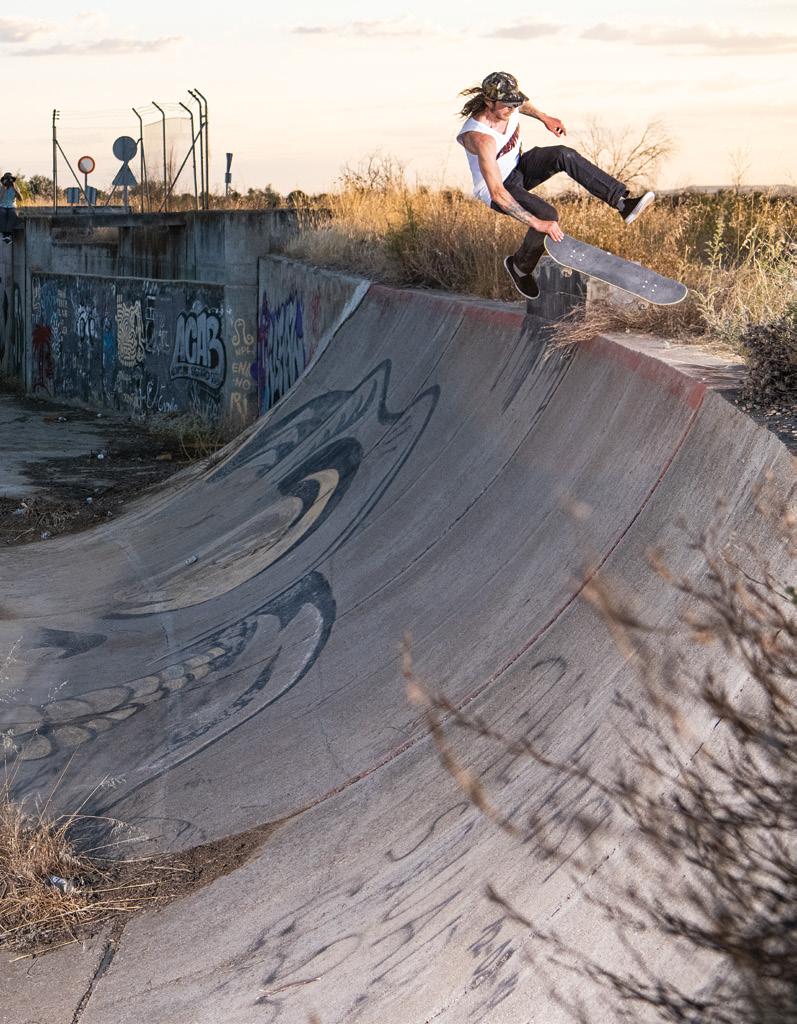

“Embodies everything fly fishing isn’t.”
I’ll never forget that comment on the video behind our first cover of The Mission, shot by Oliver Kruger at the Castle of Good Hope in Cape Town. The cover featuring Conrad Botes holding a carp caught on a stompie (cigarette butt) fly in the Castle’s moat was a guerrilla operation, and both the image and the video were shot the way skateboarding videos are, rough and ready, dodging the authorities, pulling off the trick. The comment came from a guy who I had seen around club events. He seemed OK, regular trout guy, dabbled in tying some salmon flies, etc., but he clearly did not appreciate the direction we had embarked upon with The Mission.
I’ve thought about that comment so often since then. It can be seen as criticism or a compliment. I prefer the latter even if it was not meant that way.
Pro skateboarder David Gravette makes me think about it too. Watching what he does for a day job – skateboarding all day, blasting insane tricks in the underbellies of cities or charging through what looks like the bowels of hell (but is in fact Florideah Swampfest, a muddy extravaganza that looks like the bastard offspring of the X-Games, Glastonbury and the now defunct Testy Fest) – there’s little doubt that by our YouTube Karen’s traditionalist standards, David “embodies everything fly fishing isn’t.”
But, if you can let go of any pre-conceived proprietorial bollocks over who fly fishes and how they do it, it immediately becomes clear that David Gravette is a fly fishing fanatic of the highest order. He might be several solar systems away in time and space from the likes of Halford and Skues (unless they too had “Thrasher King of the Road” tattooed into their eyebrows), but fly fishing permeates David’s life from the rod that goes everywhere in his van when out skateboarding to the artwork on the decks of his sponsored skateboards.
When we interviewed him for this issue, David had recently moved out of Portland, Oregon to a town 20 minutes way. It was a push and pull thing. Portland’s tweakers (meth addicts) were making it uncomfortable to leave his partner at home to go on skate trips. In their new home, he has deer in his backyard and a small lake within walking distance where he can catch bluegill and bass in the summer. The rest of the time, in between skating, he’s either trying to swing out winter steelhead, catch trout in high mountain lakes, or land bass and his beloved carp in less savoury water sources.
The Mission (TM): David, you’re a fascinating character, mainly because you obviously excel in the skateboarding world, but now people see you coming to prominence in the fly fishing scene, a world traditionally associated with old men with extreme ear hair who pick up roadkill and wear tweed OR wanker bankers paying big bucks for high-end fishing. How did you come to fly fishing? David Gravette (DG): I’ve always been into the outdoors. I was in tracking class when I was a kid, my family did backpacking and stuff like that. I did do fishing as a kid, but it was mostly gear. My dad fly fished. We’ve recently been talking about it and I said, “Damn dad, why didn’t you get me into this earlier?” He said, “I know, I’m sorry, but we’d get to the lake and I just wanted to fish. I didn’t have time to fish either, so I’d let your mother deal with all your snags.”In 2017 I went through some real bad injuries. I had mega shoulder surgery and had two years off. As soon as I got better from that, my hips started dislocating and I had to get hip surgery.
TM: We heard you earned the nickname Captain Dislocate. DG: Yeah, it kept dislocating and I thought skating was over for sure so I was real low. I’d started kayaking for a bit of rehab on my shoulder when one of my roommates at the time, Nick Kenny, said, “You have to troll a fly line if you’re going to kayak.” I didn’t know what he meant because I thought that fly fishing was super-complicated and it was going to be too much to learn. He explained that you just drag the line behind you. So we went out to the lake, did that and caught five fish. From there I just started learning, doing a bit of casting from the kayak. It’s great to learn about fly fishing from a kayak or any floating thing, because if you get discouraged with your casting, you can just paddle around the lake and explore and catch fish every now and then. I never thought I would find something that I cared about as much as skateboarding, but yeah, I’m incredibly frothy. I love fly fishing so much.
40 WWW.THEMISSIONFLYMAG.COM

“I DON’T THINK THERE IS ANY BETTER CROSS TRAINING FOR SKATING THAN WADING RIVERS.”
TM: Did fly fishing help you find your confidence after the injuries?
DG: I’ve been hurt a lot my whole life. I’ve had like 14 surgeries now, with tons of time off. It used to be really difficult to come back; it would take me a couple of weeks, maybe even a month to feel like I had board control again. Since I’ve started fly fishing all the time, if I get hurt and don’t skate for six months, that first day back on the board, I’m filming like four or five tricks. I don’t think there is any better cross training for skating than wading rivers. You’re learning to be light footed; every foot you place down triggers all these different muscles that don’t really know what kind of balance they’re going to find. Those constant little adjustments are exactly what you need in skating.
TM: Talking to other skateboarders about this, have you converted any into fly anglers?
DG: A lot of people who have struggled with being able to skateboard on a regular basis, have picked it up. But also, some people just seem to get the bug and others don’t. They don’t get how powerful it is. I think it’s a great excuse to be in nature for a long time while you’re also trying to be quiet and cover ground. So many times, the highlight of your day fishing has nothing to do with catching a fish but something cool you see.


TM: Would you say that skateboarding and filming difficult tricks can be similar to fly fishing? Like the challenge of catching a fish where you’ve got to pull everything together in a very specific way?
DG: I haven’t experienced anything that comes closer to the feeling I get when I accomplish something really hard in skating – either something I had to really scare myself into doing or something that took me hours and hours. That feeling of “I can’t believe it!” is one of the greatest feelings and the only other way I’ve like felt that is when I get a really good fish. Something you’ve worked so hard for. Like catching a 10 pounder on like 5X or getting through some crazy battle or the first time I swung up a winter steelhead. There’s no skate trick that I tried for as many hours as I did trying to catch a winter steelhead. That took eight months, mostly because I was fishing the wrong river.
TM: What are the best and worst parts about being on a Thrasher King of the Road tour?
DG: Best part is watching somebody else do something absolutely ridiculous and painful and suffer. Worst part is being the one who’s doing the totally ridiculous, painful suffering thing. It’s a rollercoaster for sure. Some of the most extreme fun I’ve had and the hardest I’ve ever laughed was on King of the Road. Thereare times when you’re so sore and beaten up that if you weren’t on tour, you would not skateboard that day. There are all these ridiculous tricks that on the list you go out and try something that you wouldn’t ever try even when feeling your best. You do everything you can for your team.
“AND ANYWAY CARP ARE JUST ASSHOLES, MAN. THEY’RE THERE ONE DAY AND THEN GONE THE NEXT.”
TM: Tell us about your obsession with carp.
DG: The most important thing with carp fishing are the conditions. My friend KC Badger always says the three things you really want are 1) fish, 2) vision to see the fish, and 3) the fish being willing to eat. Usually, you get to pick one out of three. Often you’ll see them a bunch, but they’re hard to get to eat. They’re hard in general, but sometimes they’re just willing to eat anything. Other days you’ll find them willing to eat, but it’s windy as hell, and you can’t see anything. You can see the shadows and you know you’re in the vicinity, but you just can’t see them eat your fly, which is so important. Around here in the summer, it’s really hard to get a clear day when it’s sunny and also not windy, or the other way around. The dream is to walk the flats and sight-fish carp like you do permit or bonefish. I’ve experienced it but not very often.
More often than not I’m being extremely sneaky walking around the edges of really muddy water where there is zero clarity. I’ll see a fish feeding right on the edge and I’ve just got to make a really short stealthy cast. I catch a lot of carp with just a foot of line out and I’m just sneaking up to it, extending my arm and dipping the fly next to its mouth. It’s the coolest thing, they’ll literally quick turn, suck it in and you set. It’s also really fun to make a far cast at one that you can actually see and watch it break its path and come over. I love when you’re walking the bank and you see some coming and you can run up ahead and cast where you think they’re going to be and just leave your fly there till they get closer. Then you start popping it a little bit and then they’ll swim down and suck it up. In those situations, when you can fish them on the flats and the bigger water, you have way more room to let them run than when you try catching them in slews and ponds where it can be tight-quarters war.
TM: How did you get hooked up with Redington?
DG: Really early on when I started fly fishing, I was becoming friends with KC Badger through biking because I also like the BMX scene. The first day we went fishing together, I still had my dad’s old rod, a 70s Fenwick. KC gave me a complete Redington Crosswater setup and it was way easier, I loved it and I fished the hell out of it. KC’s obviously sponsored by Redington and we’re all homies, so I was just tagging Redington, and they started messaging me, sending me stuff and it grew from there.

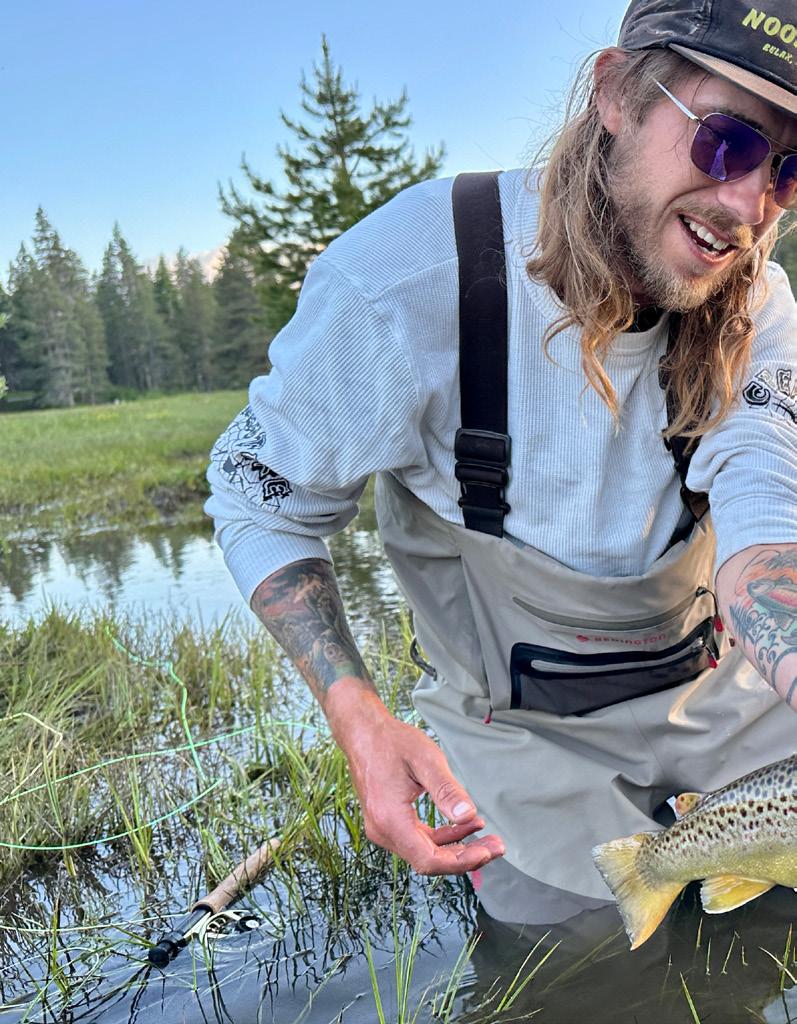

“A WISE MAN ONCE SAID, NOTHING BEATS CATCHING A 10INCH TROUT ON A MOUNTAIN LAKE WITH A FLY ROD.”

It’s been incredibly beneficial. I don’t know how I would fish as much as I do without their support. I go through things and fly fishing is too expensive. Luckily, Redington has got a lot of quality stuff at an affordable price. I think for many people their favourite part about fishing is buying gear. Like every time they go fishing. It’s probably the only thing keeping fly shops in business so I guess that’s good, but you don’t need to have all the gear to go catch fish.
TM: Tell us about the film you made with Redington, Concrete Is Hard, So Are Carp.
DG: That was a collab with RC Cone, his Tributaries film company and Redington and it was my first time doing something like that. I’ve been in that position a hundred times skateboarding, but this was different. For skateboarding films I only have to rely on myself to not get drunk the night before, pick a couple spots and hopefully not get hurt. Shooting a fishing film was tougher. In the weeks before they were showing up, we had to get film permits to film where the carp were. The towns were like, “What are you talking about? You want to film in this disgusting fucking cesspool?” It was weird, trying to scout the locations, get everything dialled in. And anyway carp are just assholes, man. They’re there one day and then gone the next. I had this spot pretty dialled. I’d been there a few days before the dude showed up and I saw hundreds of carp. I fished it very light, just

caught two really easily and then decided to let them chill before coming back a couple days later with the film crew. While filming we walked and saw no carp. Eventually I got incredibly lucky because I saw one carp and normally you have to cast way more to catch one but I got my fly in front of it and it ate the fly. That’s the one that was in the shot. I thought it was just going to get better from there, but it proved to be tough. I hooked two massive ones, but they came off for no reason. I kept fishing and it took me a while to realise that they’d bent my hook out. Thank God we got that one.
TM: Do you think fly fishing videos could be more like skate videos with dudes having parts and rad soundtracks?
DG: Yeah, definitely. When I first started getting into fly fishing and I was watching a whole lot of YouTube, most of the videos were really boring to me. OK, here’s another dude. We’re on the side of the river. We’re gonna be fishing a size 18 caddis and casting into that specific drift. Very cut and dry. You didn’t feel like you got anyone’s actual personality, you didn’t see any of the shenanigans that had to be involved with a good trip. That’s why I really liked Redington gear, and all those Tributaries films. In fly tying or fly fishing videos, I think the problem is people believe you really have to be good at talking about yourself. Redington’s more about just having fun, goof off, whatever. It’s fishing, don’t take it so seriously.
38 WWW.THEMISSIONFLYMAG.COM

“I TIED A CLOUSER MINNOW WITH THE PIN THAT CAME OUT OF MY FOOT FROM THE SURGERY. IT’S IN THE CONCRETE IS HARD FILM.”




“IF I’M OVERTHINKING, I’M NOT HAVING FUN ANYMORE. I LIKE TO DO WHAT JUST FEELS RIGHT.”
TM: When it comes to fishing there’s serious and then there’s SERIOUS. The guys who bring sand back from desert islands to put onto their crab patterns for the next trip and the guys who sit at home on a Sunday night, tying and retying their knots blindfolded, like some kind of fly fishing ninja.
DG: I got you. I have buddies that when we steelhead, they’re incredibly methodical about every cast. That’s probably the right thing to do. For me at least, if I’m overthinking I’m not having fun anymore. I like to just do whatever feels right. The other day when I was steelheading I caught a steelhead on the swing and I was stoked. It was the first hole I got into that day. Then at the next hole, I saw a whole bunch of suckerfish and they wouldn’t bite. So I ended up being at that hole for two hours, trying to get those suckerfish. I had a moment where I was like, “What the hell am I doing? I should be steelheading.” Then I was like, “Wait, am I having fun? Is this fun? Then I’m just going to do this some more. Cause I do want to catch one of these suckerfish.”
I’m the same about having to research stuff on the internet. I’ve literally never looked up anything about fly fishing on the internet. Luckily I’ve had friends show me some stuff and I’ve done a lot of learning on the water. What’s so cool is that I’ve caught really nice fish doing completely the wrong thing. I probably wouldn’t have caught those fish if I had known better, because sometimes what it takes is to be so wrong that you’re offering the fish something different to anything that it’s ever seen.
TM: Would you classify yourself as a lucky angler?
DG: Sometimes. I go through waves where I feel like I can’t lose a fish, even though I’ll do everything wrong. And then there are times when you’re like 60 fish on without catching one and you feel like you can’t catch a fish for your life. It can feel close to a gambling addiction for me. Like those times when you’re cold and hungry and the fishing isn’t good. You should just go home and there’s nothing wrong with doing that, but I won’t. I’m like a gambler sitting there, chain smoking, believing that the day’s not lost yet. I could still catch that really good fish and then it’s all worth it, all the hours of driving, being soaking wet, the hunger... My strongest skill in fishing is fucking tenacity.

TM: Do you ever mix the two, skateboarding sessions and fly fishing missions?
DG: Yeah, definitely. Mostly if I have a trick that I want to do somewhere, if it’s in a town an hour away, I’ll know there’s somewhere to fish and that’ll be my motivation to go do what I have to do to go fishing. That’s the reward. There’s lots of days in the summer, where I fish probably every day. Even if I go skate all day, I always have a fly rod in the truck. I’ll dip away from skating to fish or vice versa.
TM: What is your best skateboard setup and rod setup in the truck?
DG: I’ve been riding the same cruiser board with soft wheels, but if I was going to keep a board with me, it’s usually the trick board, 8,3 Creature. For the fly rod, I like the Redington Wrangler 7-weight. You can fish a small dry fly with that if you have to, but I’ve caught plenty of salmon and steelhead on it too.
TM: What are your other essentials for a fly fishing trip?
DG: Two thousand flies. I have a real problem with bringing way too many flies. My fly boxes get so unorganised and I get so worried that I’m going to not have something I want, that I just have too many and then I can’t find what I need. I’m trying to keep all my flies in these little plastic drawers looking like a fly shop in one of my rooms, so I can just go in there and grab what I want for the day.
WWW.THEMISSIONFLYMAG.COM 67
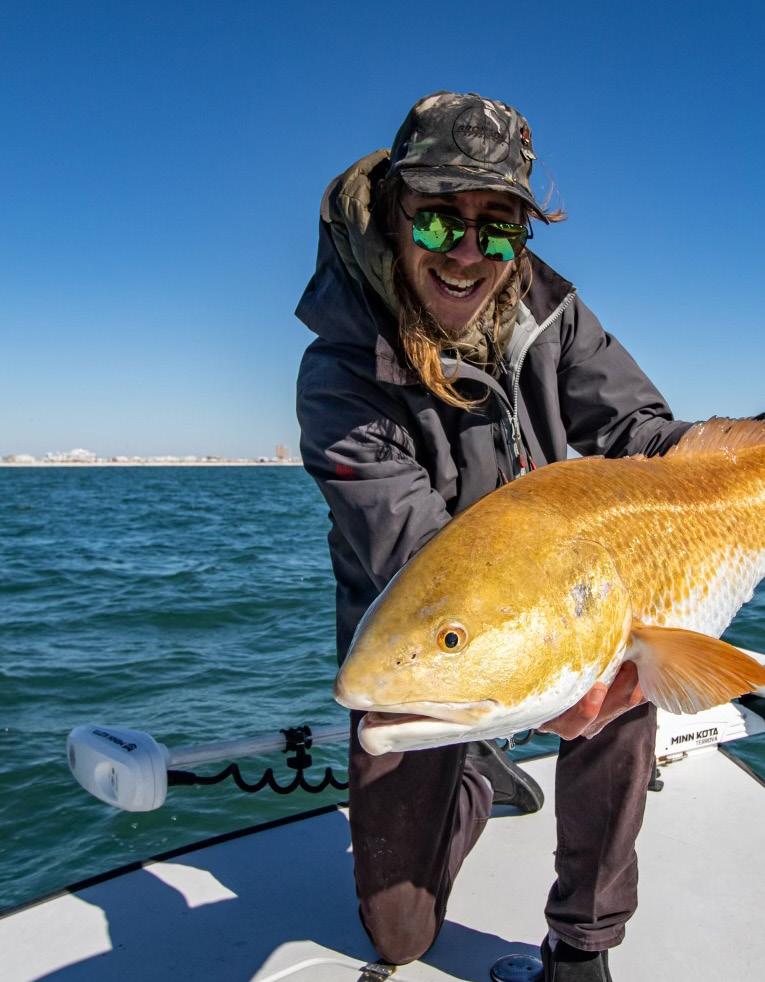

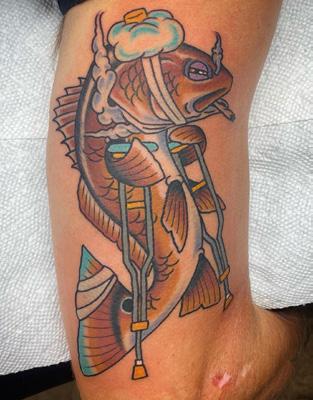
“I’M INCREDIBLY FROTHY. I LOVE FLY FISHING SO MUCH.”
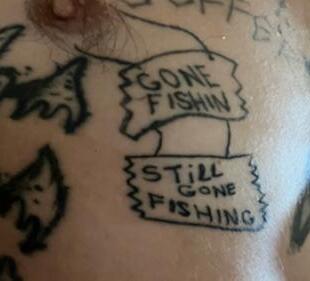

“IT’S FISHING, DON’T TAKE IT SO SERIOUSLY.”
TM: Are you tying your own as well?
DG: I’ve been super-bad. The last time I got surgery I took up fly tying for three months and was doing it a whole bunch. Then as soon as I got healthy enough to start walking around and go fishing again, I just spent all my time fishing. A problem with fly tying is that you’re going to have to look stuff up on the internet. I don’t know how I’m going to get away from my fear of the internet and learn any more patterns. Everything that I tie is just something that I’ve tied with a friend. Chironomids were the first thing I tied and that’s super-easy. Then Woolly Buggers. I’ve tied a couple steelhead flies that came out awful. I tied
a Clouser Minnow with the pin that came out of my foot from the surgery. It’s in the Concrete Is Hard film. They decided that the footage of the doctors removing the pin was too gnarly, and they also cut out some of the detail of my injuries. We decided to tie the Clouser out of my toe pin and go catch a bass. We thought it would be freaking easy. Of course, there were no bass. This hook is thick and there’s no barb, so the bass can get off pretty easy. I did finally catch one. It’s scary as hell to fish. I don’t want to lose it, so I only fish it where I know I can go get it. Like fairly shallow, clear water, tied to a thick leader.
70 WWW.THEMISSIONFLYMAG.COM
TM: Compare the places fly fishing takes you to the places skateboarding takes you.
DG: Skateboarding has taken me most places in the world, but usually to the grimiest parts of cities. It’s cool, because a lot of people go on vacation to these cities and really have no idea what it’s really like. We get submerged in the culture and people. I just wish there could be a little more nature involved. I’ll watch mountain bike videos and I’ve often thought, “Damn it, I should have been a pro in one of those fields so I’d be out in these amazing places instead.” I’ll go to like Malaysia, but won’t see the jungle. That’s where I’d really want to go. I don’t know if fly fishing will ever pay any bills, but if I can I’d like to get on trips and go fish foreign lands and crazy up my species count. That’s my favourite thing in the world, catching new species.
TM: What’s the average career span of a pro skateboarder? How long can you keep going?
DG: I’ve been incredibly lucky to have had the career I’ve had. Average pro skater careers are way too short. You see people come and go and a lot of the time it’s just because they got hurt. I was lucky enough to get in so long ago that I got pretty established and I have good sponsors that understand that I’m going to get hurt.
TM: Do you see fly fishing as just always being a fun thing you do, or do you see yourself possibly making a career in it?
DG: It seems tough. You go back to A River Runs Through It and the brothers asking each other, “What do you want to be when you grow up? A professional fly fisherman? That doesn’t exist.” It does exist now, but it’s tough. I mean, there’s guiding, but I don’t know if I have that in me. I’m so bad at teaching people how to do things ’cause I was never good at taking advice. My whole life, with anything physical, it hasn’t made sense for anyone to explain it to me. I just have to do what feels right for my body.
TM: You mentioned wanting to do more trips through fly fishing. Where do you want to go?
DG: I’m definitely intrigued by the tropical stuff like the Amazon, because my whole life I’ve been into reptiles and amphibians so I’d be catching those as well as fishing. Then there’s the Seychelles with all the giant trevally, the bonefish and proper tropical flats. I haven’t done much of that kind of fishing, but I did get to go out and fish for redfish in Alabama and that was really fun. I definitely want to do more of that, but I could never be an ocean guy. Like, I don’t understand people who only fish the ocean. It’s really pretty and nice, but there’s not enough nature for me. I need forests, mountain lakes and streams. Like a wise man once said, nothing beats catching a 10-inch trout on a mountain lake with a fly rod. Who was that? I can’t even remember. It might have been me. I don’t think it was. Whoever it was I think I heard somebody say it a long time ago and I just always thought of it as one of the most biggest truths in this world.

Redington Wrangler 7wt farbank.com xplorerflyfishing.co.za



Bajio Snipes Glasses. bajiosunglasses.com

Redington Noon Patrol Hat. farbank.com xplorerflyfishing.co.za
Redington Sonic Pro HD Waders. farbank.com xplorerflyfishing.co.za

Redington Rise Reel. farbank.com xplorerflyfishing.co.za

Redington Prowler Pro Boots. farbank.com xplorerflyfishing.co.za

Redington Rise Reel. farbank.com xplorerflyfishing.co.za
THE BEATS - DAVID GRAVETTE
David’s love of country music is welldocumented in his skateboarding videos so for this issue of The Mission he has put together a playlist of his favourite country tracks. You get Luke Bryan (“Huntin’, Fishin’ and Lovin’ Every Day”), Hank III (“Outdoor Plan”), Sturgill Simpson (“Paradise”) and more.
Press play

David Gravette Pro Model board creatureskateboards.com
SHOP THE MISSION DAVID GRAVETTE
SALAD BAR
THE MISSION - SKY BLUE GRUNTER T
Our Coral Grunter T-shirt sold out in record time, so we have forged a second run of this design, now in Sky Blue: It’s the colour of a perfect sky on those days when the fish are on and the livin’ is easy. Carrying the same quizzical spotted grunter on the back, and The Mission logo on the front, people will stop, turn around, and stare (in a good way). themissionflymag.com
“IT’S THE COLOUR OF A PERFECT SKY ON THOSE DAYS WHEN THE FISH ARE ON AND THE LIVIN’ IS EASY.
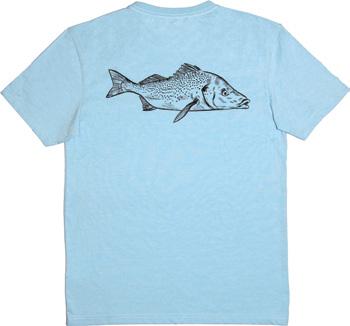
FERA - WANDLE VEST
Picture this: It’s been a good, long day on the water and it’s taking everything you have to retire the rod and make it in time for pints at the pub. You’re running late, and you need something that will “effortlessly take you from day to night”, that very specific quandary the fashion magazines promised we all would one day face. Enter the Fera Wandle Vest (not to be confused with a feral wandle, which is banned in 78 countries), named after the River Wandle which runs through South London. Built from hard-wearing cotton canvas this gilet, with its two front pockets, a secure internal pocket, recycled buttons, a soft corduroy collar lining and an embroidered logo, is practical enough for a full day’s fishing and chic enough for the razzle. feragb.com
“PRACTICAL ENOUGH FOR A FULL DAY’S FISHING AND CHIC ENOUGH FOR THE RAZZLE.”

REDINGTON - ORIGINAL FRESHWATER KIT


If you’re getting into fly fishing and don’t know where to start, it’s hard to look past the Redington 5-weight Original Freshwater Kit designed first and foremost for targeting trout. This medium-fast action rod has enough backbone to fight solid fish, but it also delivers dries, nymphs and streamers with aplomb. It’s paired with a Crosswater Reel with durable composite frame and carbon disc drag, a RIO Mainstream 5-weight line and a RIO Powerflex 4x tapered leader. Assuming you don’t have feet for hands and a pumpkin for a brain, this all-rounder combo will do a great job on dams and medium-sized rivers and catch you trout, bass and a spread of other species. Comes with a durable nylon carrying case and a one-year warranty. farbank.com, xplorerflyfishing.co.za
RIVERMAN - LEATHER CT TRAVEL BAG
For your non-fishing clobber that does not need a high-performance synthetic material bag, think of this beauty as the ideal weekender. Made in Dullstroom by Mavungana Flyfishing’s in-house leather workshop, it’s got reinforced handles and a comfortable leather shoulder strap. You can even have it customised with your name (perfect for those “Do you know who I am?” amnesiac moments) and it’ll age beautifully just like you, you leathery bastard. flyfishing.co.za

LATEST RELEASES
72
WWW.THEMISSIONFLYMAG.COM
PONGOLA
Join us for a world class tiger fishing experience within South Africa’s borders. Led by senior guides with well over 20 years experience, on this marvellous fishery our guests get results year after year.
2024 - sold out. 2025 - filling fast.







Mavungana Flyfishing Center Main Road, Dullstroom, 013 254 0270 Mavungana Flyfishing JHB, Shop 3B Illovo Square Shopping Center, 011 268 5850 travel@flyfishing.co.za www.flyfishing.co.za
SCIENTIFIC ANGLERS - SWITCH TIPPET HOLDER
From time to time we are caught between bags, vests or packs and we neglect our tippet holders for a day out. The result – tippet haphazardly stuffed into pockets (often then lost) or dropped into the bottom of a pack resulting in frantic scrabbling – is regrettable. What we need in those moments is Scientific Anglers’ powder-coated aluminium Switch Tippet Holder which keeps up to eight spools organised and easy to access. Attach to your vest, sling or boat bag and choose from a horizontal or vertical orientation. scientificanglers.com, frontierflyfishing.com
“KEEPS
UP TO EIGHT SPOOLS.”
GNARLY HEADZ - POPPERS
By now you have probably seen the new Gnarly Headz popper heads designed by Arno Laubscher (if not, check out the interview we did with him on our YouTube channel). In short, Arno put a vast amount of time and effort into developing the ultimate popper head, a design that maximizes your hook-up ratio, at least on the water.

SEMPERFLI - SYNTHETICS
Xplorer has a range of new Semperfli materials available including peacock herl, marabou and king marabou. Perhaps you are asking, why go synthetic when you can have the real thing? Glad you asked, Mr Fleshlight. Peacock herl, for example, is now problematic because CITES (Convention on International Trade in Endangered Species of Wild Fauna and Flora) has added common peacockpheasant, grey peacock-pheasant and iris peacockpheasant to their list of endangered species. That means that if an over-zealous customs agent wants to confiscate your fly tying material – or even your flies – over a lack of proof that they do not contain red-listed materials, they can. Designed to imitate natural peacock herl, Semperfli’s Synthetic Peacock Herl 2mm Extra Small Black Peacock is a fritz/chenille which contains all the iridescents that you find in the natural version with accents of blue, green, copper and gold. Hans van Klinken is a fan and uses it for the thorax on his Klinkhamer.

We’ve tied and fished with them and have been suitably impressed. However, if you do not tie yourself or are too busy to get to it, you can now buy complete Gnarly Headz poppers (bass popper, saltwater poppers, you name it) made by SciFlies in Mbombela. Cut out the middleman (you) and go straight to the source. scientificfly.com




Semperfli’s Synthetic Marabou and Synthetic King Marabou, however, were created to address the issue of quality of natural marabou, rather than dealing with the issue of customs. With guaranteed consistency in fibres, these can be used for Woolly Bugger tails or as winging and tails for streamers. Made from a very fine core, they’re easy to use, have movement that matches natural marabou, and come in a stunning range of colours. semperfli.net, xplorerflyfishing.co.za
74 WWW.THEMISSIONFLYMAG.COM
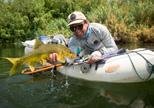

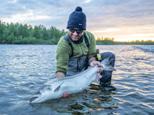







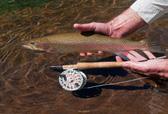
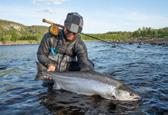





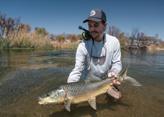






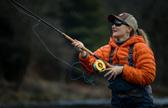









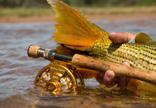

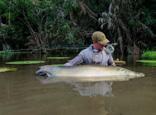
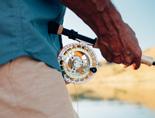




shiltonreels.com | sales@shiltonreels.com CHOOSE YOUR COLOUR

TOPO BAGS

We’re long-time fans of Topo Designs, the Coloradobased bag and apparel manufacturer that excels at both its own designs (check out the OG Klettersack) and also collabs (Howler Bros, Redington, Tenkara Rod Co.). Now, praise be unto the packhorses of Valhalla, Topo is available in South Africa and you can browse a selection at

FISHPOND - FLAT TOPS WADER DUFFEL
Take a look at your car boot after a day’s fishing and there’s a good chance it’s a funky-smelling badger’s nest of boots, waders, reels, rods and garage pie wrappers. Despite what your better half might think, there is a need for an in-between bag. A bag like Fishpond’s Flat Tops Wader Duffel, which has a ventilated lower storage compartment for wet waders and boots, while the upper storage compartment is perfect for vests, packs, clothing, and snacks. Like most things Fishpond, it pairs perfectly with another product, the Dakota Rod and Reel Case, keeping you supremely organised before you leave to go fishing, and also when you come back. fishpondusa.com, frontierflyfishing.com

Mavungana Flyfishing. Check out the Mountain Waist Pack and Mountain Hip Pack for great day-trip bags that are perfect for holding all your fly fishing accoutrement, while their accessory bags in various sizes help bring order to the chaos of your tippet, fishing licence, wacky tobacky and other goodies. topodesigns.com, flyfishing.co.za
PATAGONIA - BLACK HOLE DUFFLES AND WHEELIE DUFFELS
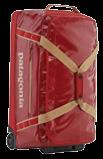
Fresh in at Xplorer Fly Fishing is Patagonia’s new range of Black Hole Duffels and – for those with backs that go UUUURRRRGH getting out of couches –wheelie duffels too! Made from 100% post-consumer recycled polyester ripstop and lined with 200-denier 100% recycled polyester with a polyurethane coating, these bags are highly weatherresistant and bloody tough too. The main compartment opens via a zippered U-shaped lid, which has a pair of mesh pockets on the underside for easily lost items like earbuds and a charger. A zippered exterior pocket holds all the stuff you need to access quickly (e.g. checking for your passport for the 17th time). The padded bottom panel adds structure and helps cushion the load when your duffel gets the baggage-handler treatment. Carrying options include padded, removable shoulder straps, webbing handles with a snap closure and haul loops at either end for linking multiple bags. Daisy chains let you lash additional gear to the outside. Various sizes available. patagonia.com, xplorerflyfishing.co.za

WWW.THEMISSIONFLYMAG.COM 76
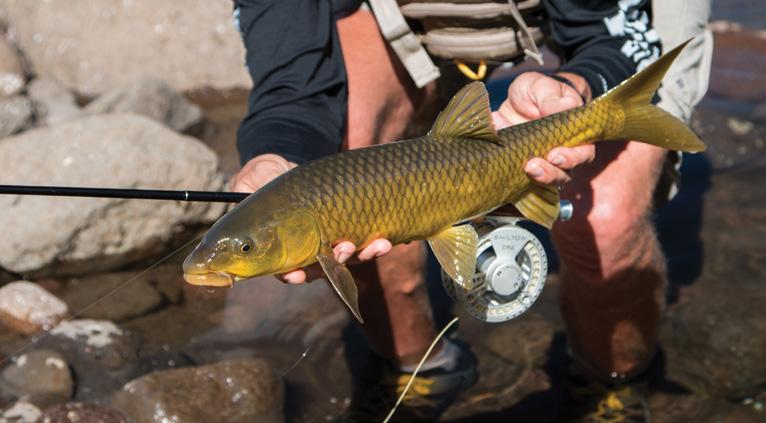

TROUT BOSS
For versatile anglers who target trout in every season.

FULL SINK TYPE 6
An easy handling sinking line that will get your fly down fast and effectively.

TROUT ALL PURPOSE
Durable, high-floating, general-purpose fly line available in a weightforward taper.

COMPACT INTERMEDIATE
Designed to be our most versatile intermediate fly line.

SPRING CREEK
444 Spring Creek remains supple in the coldest conditions.

CLEAR CAMO
The 444 Clear Camo line disguises itself extremely well in a variety of different water types



COMPACT FLOAT
A full floating short, compact, aggressive head design that shoots an extreme amount of line.

FULL SINK TYPE 3
Great for subsurface tactics in lake and river applications.
Cortland is distributed through Catch | Contact: sales@shiltonreels.com | cortlandline.com
FRESHWATER SERIES

THE MISSION
BTOB & CTHULHU RIPSTOP
SNAPBACKS
Decisions, decisions... Out of our two new snapbacks featuring a 5-panel design, an unstructured fit and adjustable double-row polysnap, which of the Conrad Botes designs do you go for? The Beautiful Thing of Beauty (a phrase immortalised by Herman Botes in Issue 32’s “No

Country For Old Men” describing a fish, but it would work just as well for a view, a sunrise, a bug dancing above the water in a shaft of light…)? Or, the noodly greatness of the majestic cephalopod deity, Cthulhu? Why choose? Just get both while stocks last as these caps are flying out the door. themissionflymag.com
“A 5-PANEL DESIGN, AN UNSTRUCTURED FIT AND ADJUSTABLE DOUBLE-ROW POLYSNAP.”
IWANA REEL – TROUT 3”
A new release from Iwana, the 3” Trout is a classic beauty that will stand the test of time. Designed for targeting small and medium-sized troots, these are lightweight reels that perfectly match bamboo, fibreglass or other modern fly rods. Made from anodized 6061-T6 aircraft bar aluminium, expect a pleasant sound from the click pawl drag design, either a hand polished Ebonite or wooden handle, a high quality, handmade suede bag and a unique reel ID for warranty purposes. iwanafishing.com, frontierflyfishing.com
ST. CROIX - EVOS FLY RODS
Having hired some industry heavy-hitters and invested heavily in their fly fishing business, St. Croix are flexing not just their muscles in the high-end rod market, but also in the features of the new Evos fly rods. Ideal for handling dry/dropper combos, light streamers, and indicator rigs with ease, the 9-foot 5-weight also boasts enough feel and feedback for downshifting to technical dry fly presentations. Advanced blank materials include ultrahigh-modulus/high-strain SCVI carbon, high-modulus

“A CLASSIC BEAUTY THAT WILL STAND THE TEST OF TIME.”
SCIV carbon, and premium-quality SCII carbon, while Mito Graphene unlocks the power of hybrid polymer materials and delivers radical hoop strength, optimised loop stability, and unfathomable accuracy. Expect recoil singlefoot guides, cerecoil stripper guides, a hook-keeper, a modified micro full wells flor-grade cork handle, uplocking, machined-aluminium reel seat with walnut insert, a micro fighting butt with composite end cap, an aluminium rod tube with rod sock and a 15-year transferable warranty. stcroixfly.com, xplorerflyfishing.co.za
WWW.THEMISSIONFLYMAG.COM 78
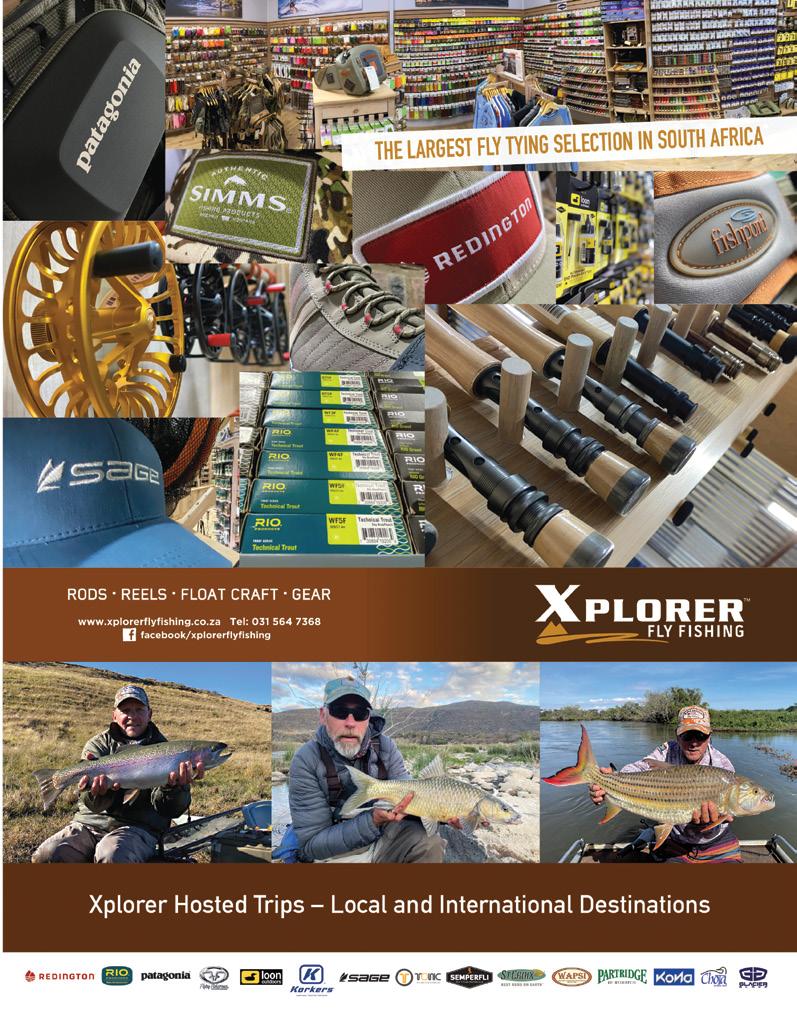
XPLORER - NETS
Xplorer has a new range of nets just in. The much-loved long- and shorthandled Xplorer Floating Nets are now available in camo grey. The Xplorer Rubbamesh Aluminium Adjustable Handle Comp nets, which feature a flip net section and a quick-folding head, are lightweight and durable, designed for swift deployment and quick, efficient catch-handling. Lastly, there’s the Xplorer Aluminum Boat net. Strong and light, this net’s extendable lock-in pole and ample net size are designed for handling double-figure fish while boat fishing, but its portable design means it could easily do duty on rivers too. xplorerflyfishing.co.za



“THE XPLORER RUBBAMESH ALUMINIUM ADJUSTABLE HANDLE COMP NETS.”
SIMMS - CARBON FIBRE FISHING RETRACTOR
Fish cruising, fly change needed. Window of opportunity approximately 31 seconds. Don’t panic, chom. Simms’s Carbon Fibre Retractor with its polyethene cord offers extension and retraction for quick tool access while the penclip-style attachment offers puncture-free compatibility with a wide range of packs, bags and apparel. Plenty of time to change up and get your shot in. simmsfishing.com, frontierflyfishing.com
ORVIS - PRO WADING BELT
Dodgy back? Looking for a little more support when wading? Then you should check out Orvis’s Pro Wading Belt. Designed to be used in place of your traditional wading belt, this abrasion- and puncture-resistant support belt features perforated foam and a breathable mesh backing with full wraparound lumbar support giving you extra support on the water. Hook and loop attachment straps on both sides come with silicone grip tabs for use with wading staff, pliers, and other tools while an integrated ambidextrous net scabbard keeps long-handled nets out of the way. orvis.com, flyfishing.co.za



C&F DESIGN - 12 TROUT GUIDE BOAT BOX
Like to take the kitchen-sink approach to flies? The C&F 12 Trout Guide Boat Box is a large fly box that can be used as either a boat box or a storage box. Designed to carry all the flies you might need when fishing from a boat, it also gives you the ability to pop out the system inserts you might need to go wading with just a few essential flies. The system foam can then be clipped into a fly case without having to move flies. c-and-f.co.jp, frontierflyfishing.com


WWW.THEMISSIONFLYMAG.COM
W ELCOME
TO OUR WORLD OF F LY FISHIN G
As a premier fishing shop, specialising in fly fishing equipment, we know that there's nothing quite like the thrill of casting a line and hooking a trophy fish. From the latest gear to
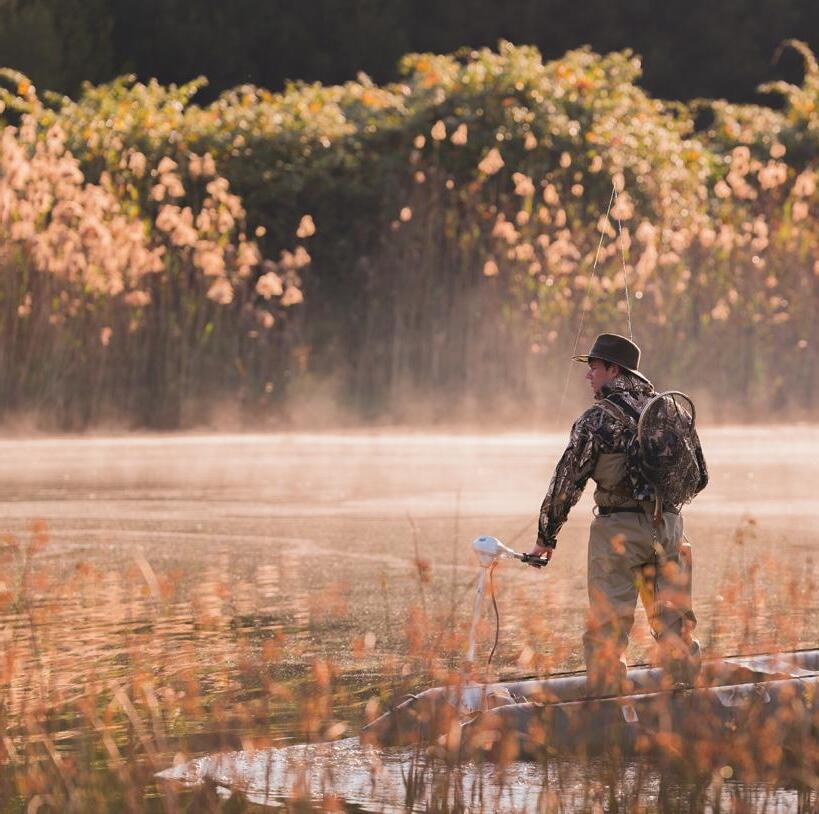
the best equipment, we've got you covered.
As experts in the field, we'll share our knowledge of the rich history and tradition of fly fishing, as well as the best destinations for your next adventure. So, whether you're a seasoned angler or a beginner just starting out, let us help you make the most of your fly fishing experience.
LOCATED INSIDE SAFARI OUTDOOR PRETORIA
Lynnwood Bridge c/o Daventry & Lynnwood Rd , Lynnwood Tel: 0861 22 22 69

www.safarioutdoor.co.za
AT Follow us on social media or visit www.so.co.za
PAY DAY
LOW-LIGHT SUNNIES FROM COSTA AND NEW OPTIONS FROM SWISS-SWEDISH BRAND
VALLON.
THE SUNNIES - COSTA DEL MAR: LIDO, SUNRISE SILVER MIR 580G
Ditching his Ray-Bans, Matt Kennedy can finally see the light and the fish.
Full disclaimer. I’m a relative noob to high-end sunnies. I know, roughly, what polarisation means (having Googled it). Little parallel slits in a lens allow for light to pass through in a single orientation only, specifically helpful when trying to look into refractive water. Said slits nullify the refractive glare from said water.
I’ve used many of the cheap(er) brands, tints and shapes around. Why would I pay thousands of Randelas for a fancy name brand? Well… Turns out you get “POoolaRiiSed” and you get “polarised”.
My slow-motion eureka moment began when I decided to level up on my local fishing. Costa’s Lido Sunrise Silver were my first pick – the low-light lenses would be ideal for the shadowy, tannin-stained Cape streams, and for general use too. After getting used to the dream-like haze of the yellow sunrise tint, and once my brain made a few colour corrections, my first look into fishy water was unbelievable. Someone had finally switched on the lights. I could see details and movement with clarity unlike ever before. Turns out I’ve been wandering around on the streams in nonpolarised Ray-Ban Wayfarers looking like George Michael but seeing like Ray Charles.


Now, it’s like I’ve unlocked a cheat code. I’m often the first one calling out sighted trout on the streams. “THERE, NEXT TO THE ORANGE ROCK. NO NOT THERE, THEEERE, POEPHOL!”, my frustration growing while I wait for companions to spot the fish too. The Silvers have also been especially useful during low-light carp missions on a nearby suburban golf course. Through the horizontal reflections of the twilight hours I am able to spot cruisers that previously I was oblivious to. No more hopeful blind-casting. At those times of day, I tilt my head to help find the optimal polarising point.

I’ve also used them in direct-light saltwater missions, cloudy and bright days on the rivers, and dusk/dawn hours on stillwaters and vleie (marshes), spotting fish all the same. The flexible frames are easy to slip on and forgotten about instantly, as they seemingly mould onto my face. The rubberised nose piece and temples keep the frame stuck to my sweaty skin. The blinders at the corner of each eye reduce peripheral light really well – although they also block out my blind spot while driving. And the rubbery Costa lanyard keeps them from falling off my face onto glass-shattering rocks. Overall? I’m catching a lot more fish than I was with my Ray-Bans. Win, win, and win. costadelmar.com
VALLON - FRESHWATER & SALTWATER REVIVALS
Founded by two brothers who ran cult retro ski-style Instagram account @Old.Schoolers, Swiss-based Vallon have now released the Freshwater and Saltwater Revivals for fishing. Both variants are equipped with Vallon’s exceptionally clear polarised V52 optics. The Saltwater’s grey-tinted lenses improve colour perception and are fully mirror-coated to protect against strong sunlight, while the Freshwater’s brown-tinted lenses improve depth perception and enhance contrasts, making them ideal for sight-fishing. These have sustainable frames made from recycled fishing nets, a rubber nose pad and a protective case with a clip-on hook and belt straps. We’re testing both with a full review to follow. vallon.com
WWW.THEMISSIONFLYMAG.COM 82 LATEST RELEASES
WE’RE SHOWING OUR METTLE

Inspired by the deep-blue waters of a mountain lake, Stanley introduces a fresh Hammertone finish onto our Legendary Classics: Hammertone Lake. Discover this new outdoorsy collection ideal for cold water activities, camping, fishing, boating and wild swimming.


Available at all leading outdoor stores & selected independent stores. Awesome Tools are the exclusive distributors of Stanley products in South Africa. Tel +27 21 981 6672 www.awesometools.co.za

IN THE BEST SHITHOLE DESTINATIONS.”
“THE FINEST SHITHOLE SPECIES


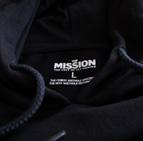





GET YOURS AND OTHER QUALITY CLOBBER AT THEMISSIONFLYMAG.COM WITH HOODIES AND CREWS, WE’VE GOT YOU COVERED SHOULDER SEASON SORTED
FLUFF PUNK MOHAWK KWAN
AFTER ALMOST TWO DECADES SPENT EXPLORING THE WEST COAST OF SOUTH AFRICA WITH A FLY ROD, WHEN IT COMES TO TARGETING SANDSHARKS, JIMMY EAGLETON’S FORMIDABLE TRAP TECHNIQUE (AND THE PUNK MOHAWK KWAN HE FISHES), ARE LETHAL.

Over the past few years, I’ve developed a technique for catching sandsharks that works well for me. Basically, I’m setting up a trap. I don’t want the fish to know that the fly is there. Every detail about this fly, the way that it’s tied and the way I fish it, is with the trap in mind. Whether I’m on the sand flats, the mud flats or the surf, this is my go-to fly. If you’re going to play the odds with targeting sandies, then this is the one I’d recommend beginners use.
GISS (general impression of size and shape)
It’s literally a Kwan, minus the legs, plus a mohawk. The chenille body is cut flat, resembling that of a Merkin, but the long craft fur tail makes it a Kwan. This pattern might represent any kind of shallow tidal critter that sandies feed on, from baitfish to mudprawn, although fishing it as a “trap” doesn’t really require any specific prey reference.
Punk it up
The choice of colour is solely for the angler to see the fly better. I don’t want the sandshark to know that the fly is there. That’s also why I don’t tie in any flash at all. I find that the purple/black combo is very visible in the sometimesbrown water along the West Coast, although yellow-andwhite colourways work really well too.
Photo. Matt Kennedy
1 2 3 4 WWW.THEMISSIONFLYMAG.COM 86
Make the circle (hook) bigger!
J-hook equals foul hook. Because of the sandshark’s mouth is on its flat belly underneath, it’s really easy to foul hook. This is why I use a circle hook. However, I alter the hook point slightly by bending it with pliers, simply to open the gape a little bit more. I want to increase the area on which the sandshark can bite down for a successful hook-up, without the hook snagging on its fins as it swims over the fly. The angle of the hook point must aim directly to the hook eye. If I rub the hook, point down, on a flat surface, then I shouldn’t snag on the point. That’s how I know I’ve bent it just enough. This way, the hook point will slide along the sandshark’s flat underside, and hook into the first gap it finds – that being its mouth.
Four chainz
I use four bead chains instead of two. This makes the fly heavier towards the hook-eye, making it sink faster. The wider frame acts as an outrigger, preventing the fly from flipping over once the sandshark has pressed down on it. The four beads also create a bit of vibration in the water, which is an added trigger for the sandshark to bite down.
Spiky mohawk
When the fly is flat, the rooster-feather mohawk is the highest point on the fly. As the sandy swims over the fly and you give it a twitch, the mohawk will be the first thing the fish feels, and bites. The mohawk is tied directly over the hook point and acts as a target for the sandy to bite down on, hopefully resulting in a hook-up.

Rig-marole
To add weight to the front of the fly, I tie a tungsten bead onto the Rapala loop, wide hole facing forward. This helps sink the fly much faster, ensuring that the trap is laid exactly in the intended spot on the sand or mud bottom. The open hole fills up with sand which acts as an anchor for the fly. The brightly coloured bead also makes the fly easier to see.
The whadda Kwan?
Tied by Patrick Dorsy, the Kwan fly was originally intended to imitate small bottom-dwelling baitfish and shrimp to target bonefish on the Florida flats.
RAPALALALALA
Tying the Mohawk Kwan on with a bigger-looped Rapala knot means that the tungsten bead can move more freely, sinking the fly faster.
It’s a trap!
Taking all of these steps into consideration, there’s a very specific way to fish this fly. To start, find an area where sandsharks are cruising. If the fish is too far away, so far that you won’t be able to see your fly, then don’t cast. Equipped with your best 6-weight, a lead core line, and a very short leader, put the fly rig into the zone. You have to lead the fish and overcast. Then, quickly drag your fly to the point of interception, i.e. where the fish’s mouth will be in a few seconds’ time.
Because of the fly’s flattened streamlined shape and the heavy weight of the bead chains and bead, the fly will sink very quickly, directly 90 degrees downwards, and lie flat. Once the sandy’s eye is positioned over the fly, that’s your cue to twitch. Twitching the fly will cause the sandy to go down and bite onto the mohawk target. Keep dragging the fly with your retrieve hand to keep tension.
You will see the sandy puffing sand, and will know very soon if you’ve had a hook-up. Once the sandy realises it’s hooked, it’ll take off.
“THIS PATTERN MIGHT REPRESENT ANY KIND OF SHALLOW TIDAL CRITTER THAT SANDIES FEED ON, FROM BAITFISH TO MUDPRAWN.” 1 2 3 4
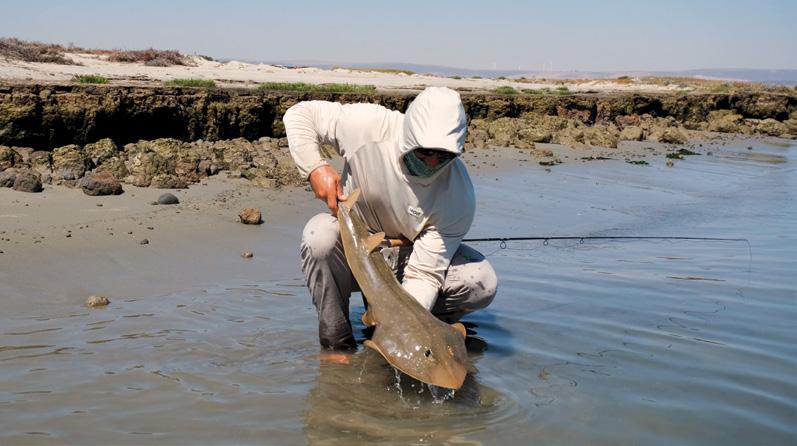
“AS


Houdini
Our latest short film, Houdini by Matt Kennedy, showcases the sandshark fishery on South Africa’s West Coast. It stars Jimmy Eagleton and Leonard Flemming.

The Bearded Clouser Need a second fly should the sandsharks turn their flat shoulders at you? Check out Leonard Flemming’s Bearded Clouser and it’s electrochemical design elements. Step-by-step available at themissionflymag.com


Step-by-step video Watch Jimmy go through each step on how to tie the Mohawk Kwan, and how to fish it at themissionflymag.com.

87 WWW.THEMISSIONFLYMAG.COM
THE SANDY SWIMS OVER THE FLY AND YOU GIVE IT A TWITCH, THE MOHAWK WILL BE THE FIRST THING THE FISH FEELS, AND BITES.”
88 Matt Kennedy

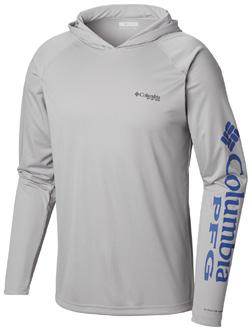
MEN’S TERMINAL TACKLE™ LONG SLEEVE HOODIE
Ideal Fishing Layer:
This wicking hoodie gives you lightweight UPF 50 sun protection in and out of the water. The sleek hood fits under a hat for extra overage.

COLUMBIASPORTSWEAR.CO.ZA @COLUMBIASPORTSWEARSA @COLUMBIASOUTHAFRICA @COLUMBIA_RSA Fishing Skin Cancer Foundation Omni-Shade™ Omni-Wick™





MOROCCO
THE SOURCE
TWENTY YEARS IN THE MAKING, A FATHER AND SON FIND THE HEART OF THEIR PASSION FOR FLY FISHING IN A FISHERY THAT NEEDS YOU TO LOVE IT TO LIFE.
Words and photos. Samuel Fretwell.
PRELUDE
Ilearned to fly fish in the high desert mountains of New Mexico. It was the summer of 2003, just months before the birth of my first child, Luca, and my dad was coming out for a camping trip. It seemed as good a time as any to try out that fly fishing thing I had seen people do, so I drove over to a local outdoor store where Chris, a dry-humoured former elementary school teacher, hooked me up with the basic gear and even threw in a free casting lesson on the asphalt of the parking lot at the back. Every time my line cracked, that smart ass muttered, “buckfifty” (the going rate for a basic fly at that time).
A week later my dad and I headed out to a high meadow stream that I had decided, mostly based on photos on the internet, would be the perfect spot. And it might have been if it weren’t for the thundershowers that mercilessly flooded the river and nearly washed away our campsite. So, after a long night huddled up in a rental van, we decided it was worth braving the mostly primitive dirt road to the other side of the mountains.
It was a good decision. The next morning, we made our way to a day-use area where two cascading streams converge before descending out of the pine forest and into the cottonwoods below.
WWW.THEMISSIONFLYMAG.COM 92
I walked the stream for about 15 minutes before I found a place open enough to try out my rookie casting skills and, whether it was beginner’s luck or hungry fish, I managed to hook six trout from a single pool. It was a new passion, and one that immediately took hold, initially because it was one of the few activities that could completely separate me from the worries of the day. Later on it helped me truly see the nature that I had, until that point, only passively admired. But it would take another 20 years, a full generational turn, before I looked closely enough, like staring at a great work of art, to find it looking back.
AÏT BOUGUEMEZ
“YOU CAN FISH HERE??”
We paused awkwardly before realising it was Karim, our disarmingly affable guide, still chuckling at his own joke, then followed suit. I knew better than to judge a region’s fishing by its urban gateways. Still, Bozeman it was not. With fly gear in tow, Luca, now 19, and I had just stepped conspicuously off a bus onto the hot and dusty streets of Beni-Mellal, Morocco. Like so many cities in Morocco’s interior, variations of peach-coloured concrete walls dominate the view, broken up by miles of shops facing open to the public, displaying their wares with makeshift aisles of packaged goods that often spill far into sidewalks.
Nearly 10 months had passed since I had even touched the smattering of fly fishing gear that I had so adamantly insisted should make the journey across the ocean. In August of 2022 I, along with my wife and two youngest boys, moved to Marrakech for work, while Luca, now graduated, headed off to Oregon for a gap year. Work was busy. Life was busy. And there were no “quick getaways” to fly fish from Marrakech, that much I knew for sure. But by early May I had to get serious. Summer was rapidly approaching and Luca was coming for a visit, and his mind is permanently stuck on that four letter F-word.
Despite all my attempts at DIY research (outdated websites and a few French YouTube videos), I was left with little to go on, save a few new French vocabulary words. Fortunately, after more searching, I was able to connect with Karim Boutellaka, one of Morocco’s only licensed fly fishing guides and someone, in my opinion, who should be chiselled into the fly fishing hall of fame, if for nothing else, for his relentless yet humble approach to conservation.
That night, after a long drive in and out of valleys angled like a child’s imagination, we settled in at a local gîte in the Aït Bouguemez valley where we spent the night before heading to our first destination. The inn perches above terraced orchards and marks the distinct boundary where dirt and rock give way to cartoonish shades of green.


Along the valley floor runs a small stream that is the lifeblood of the local villages. In the twilight before dinner, we walked the narrow stream with fly rods in hand. While most of the villagers were hard at work, often carrying loads twice their body size through the dense brush, a few boys ran along the stream with rods made from sticks and makeshift spinners. Not to be outdone by visitors, they proudly showed off their skills by cunningly lowering a spinner under the overhanging trees where they caught the occasional trout (Salmo macrostigma). They were quick to let us know that spinners and worms are the way to catch fish.
That evening while we sat among the traditional Moroccan pillows, with the requisite mint tea and tagine, Karim broke into story. He is a self-taught fly fisher and adventurer whose impressive CV is best shared like a Moroccan meal: huddled around a mountain of food.
During our meals or while driving, Karim wove through stories of trekking 30km as a child in search of fishing, learning to tie flies with raw materials, countless hours of lobbying a dizzying and corrupt bureaucracy, and patiently networking for gear that could take months to find its way across the Mediterranean, a geographically narrow distance that is, in so many ways, a world apart. In the midst of fascination, one couldn’t help but also feel a rising surge of shame for what we’ve taken for granted.
M’GOUN
The next morning we wound our way over the pass and down into the M’Goun Valley. From the top of the dramatic pass, it was hard to imagine that there was water anywhere in the valley below. Layers of rock staircase the valley with tri-coloured shades of grey distinctly marking the elevation. But as we made our way down into the valley and through a small village, another smaller valley appeared and with it a clear stream flowing between barren white rock. At first impression it appeared as no more than seasonal high mountain snowmelt, which made it even harder to believe that it maintains a trout population.
As is typical in these regions, our presence quickly drew attention. Two gentlemen approached and engaged Karim in friendly conversation. Within minutes the conversation turned to business propositions as one of the gentlemen offered to be the local “guardien”. Since the visits from scientists and tour guides, the locals had become increasingly aware of the profits to be made from conservation.
Anxious to fish, we then made our way up the stream. The M’Goun Valley, though mostly barren, is greenly pockmarked with low-growing abrasive shrubs that will punish a wayward step. Undaunted, herds of goats feed readily as they work their way across the slopes of loose rock. From time to time, stones dislodged and crashed violently into the shallow stream, serving as a poignant reminder to keep a watchful eye. “Stay on this side,” Karim told us at one point. “The rocks fall often.”
Once we entered the river valley, we could see the stream winding up into the mountains above. “Approach carefully. They are easily spooked,” Karim reminded us. So I looked ahead and chose my approach at the river’s next bend. As I approached what I over-confidently believed would be the first pocket large enough to hold trout, I heard the familiar “Got it!” Before I had even unhooked the fly from my rod, Luca had already caught a trout that was holding behind a modest-size rock in a shallow and straight stretch of river. I quickly ran back to celebrate the accomplishment.
This was no ordinary fish. The M’Goun River is one of only two remote streams inhabited by Dadès trout, an endemic, isolated, and now endangered species that has miraculously survived over a million years in its genetic state. Although it belongs to the extensive Draa River Basin, which runs 1 200km from the High Atlas range through the desert and eventually to the Atlantic, the Dadès trout survive only at the very apex of the watershed’s sources, occupying a total range of no more than 22km of our planet. Despite possibly being the world’s oldest trout, it has been a mere 10 years since a team of Spanish scientists first studied and classified this species as Salmo multipunctata
Luca was visibly buzzing with excitement. It was not the catch so much as the encounter, as Luca had decided confidently at a young age to dedicate his life to fishing and conservation. As he gazed at this rare and ancient species, he maintained it just below the surface, close enough to display the profusion of black dots from which it derives its Latin name. “Slowly,” Karim implored, as he readied the camera. Luca gently removed the hook, and then with cupped hands lowered the fish into the water where it found its bearings before darting away. It was a rare catch indeed as it would take nearly an hour-and-ahalf for him to catch another.
It had only been 24 days since we’d heard the name Salmo multipunctata and learned that the M’Goun had just opened to legal fishing for the first time. It was not just a new species to add to the list, it was an encounter with the shrouded frontlines of conservation. Morocco inhabits a difficult middle in the fight toward sustainability. It has neither the revenue of a highly developed country nor the high demand that convinces some nations that the profits of fish tourism are worth the conservation efforts.
“I usually begin fishing after the second bend,” Karim told us. The next few hours entailed slowly working our way up the valley and patiently mining each rare pocket and pool with dozens of casts. Around 30 minutes after Luca’s first catch, I found the only undercut bank with vegetation in the entire stretch. Confident that this relative mansion of habitat held trout, I cast repeatedly to the top of the run in the hope of perfectly placing my elk hair nymph into the lower current. After a handful of attempts, my fly pulled deftly into the bank. Bam! I quickly but gently moved the trout into my net. Though only 20cm, this spotted beauty was as thrilling as any I had caught before. Between pools there were long stretches of nearly unfishable water. We passed herds of goats and sheep and took in the scenery that continuously opened into what seemed like an unending path into the sky. Karim would switch flies often, carefully testing each in this relatively new frontier.
“DADÈS TROUT OCCUPY A TOTAL RANGE OF NO MORE THAN 22KM OF OUR PLANET.”
WWW.THEMISSIONFLYMAG.COM 94



“A FISH THAT HAS SURVIVED A GEOLOGIC AGE WAS HOLDING IN A STRETCH THAT CAN BE WALKED IN 45 MINUTES.”
TRANSLUCENT CASCADE
“I’m going up a ways,” I announced to the group. “No, you can’t,” Karim replied abruptly. Taken aback, I thought perhaps the area was off limits or that our time had run out. As it turned out, only a few minutes away was the literal end, or beginning, rather. High above the stream, clear water gushed out of the mountain side. It was the beginning of a 1 200km journey, and yet, for the Dadès trout it is a potentially deadly barrier that leaves them trapped in an increasingly fragile ecosystem.
Its finality was striking. We had fished to a river’s source before, but never had we been so moved. A fish that has survived a geologic age was holding in a stretch that can be walked in 45 minutes. Bucket lists be damned, I thought. I wouldn’t have wanted to be anywhere else at that moment. Below this “translucent cascade”, as Rilke wrote, “There is no place that does not see you.” If the M’Goun had all the polish of a developed fishery, it would not have spoken so loudly to the need for conservation, sustainability, and mitigation of climate change.
The walk back to the car was direct. Eventually, we climbed onto the narrow irrigation canal that ran swiftly ahead, following a highline down the valley to the villages below. This path is faster than returning by way of the river’s bank and its ankle-challenging rocks. Despite the beauty, it was a departure, both from the river below and our most significant encounter with nature to date. Soon, we made our way down the valley to where the river makes a final turn from where we had parked. “Wait down there,” Karim pointed, “and I’ll bring the car. We’ll have lunch here.”
We stood for a moment looking back at the barren rocky stream before descending the steep patches of weeds, grasses, and wildflowers that thrive on the imperfections of these ancient acequias. It was now early afternoon and only day one of our trip. The next few days were far more productive in terms of catching fish. In remote cascading streams, we caught dozens of brown trout among breathtaking backdrops of cliffs and waterfalls, but the M’Goun, with its Dadès Trout, was the most impactful. It’s a place that needs you to love it to life.
96 WWW.THEMISSIONFLYMAG.COM



From headwaters to court rooms, fighting pollution FOSAF fights to protect your fly fishing future.
Become a member today at fosaf.org.za
STERKFONTEIN
DAM, ORANGE YELLOWFISH, TANKWA KAROO, RIVER, VAN DER KLOOF, MOOI RIVER, TROUT, TUNGELA RIVER, WHEREVER RHODES, MOGGEL, LAKENVLEI, YELLOWS, ELANDSPAD RIVER, RIVER, LARGESCALE YELLOWFISH, RAINBOW TROUT, VAAL RIVER,
ORANGE RIVER, SMALLMOUTH KAROO, NATAL SCALIES, RIET RIVER, DULLSTROOM, BROWN WHEREVER YOU FISH, WITVIS,
LAKENVLEI, INJASUTI,
BUSHVELD
RIVER, CHISELMOUTH, KOMATI YELLOWFISH, PONGOLA RIVER, RIVER, SAWFIN, BARKLY EAST
pollution to challenging ill-thought out government legislation, future. For just R360 a year, you can help protect FOSAF.
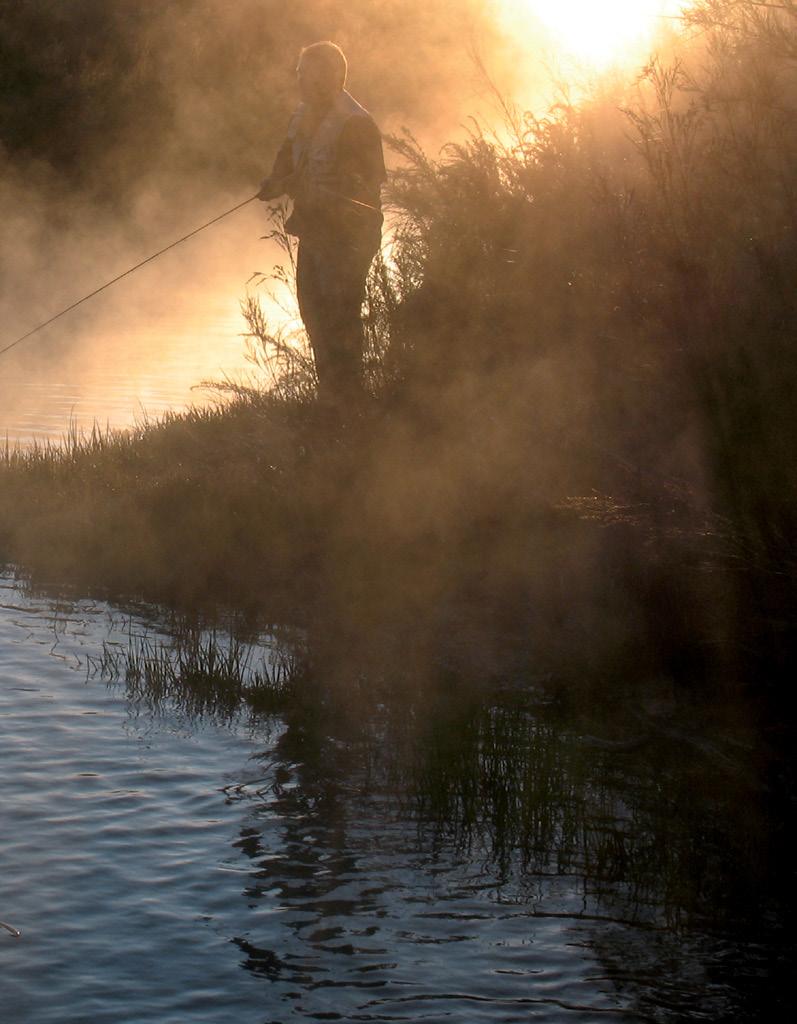

REMEMBERING TOM
AFTER THE RECENT PASSING OF SOUTH AFRICAN FLY FISHING GIANT TOM SUTCLIFFE , ED HERBST REMEMBERS TIME SPENT WITH HIS FRIEND ON THE WATER.
Photos. Tom Sutcliffe archive
“With Ed I enjoyed many trips to the Eastern Cape Highlands, some of the best times in my life, also covered in my books.”
That’s a line from an article by Tom which will appear in the June/July edition of the British magazine, Fly Culture. A day onstream with Tom was, in passing, about catching trout. It was more about achieving tranquillity. I can’t ever remember out-fishing Tom but it was not for want of trying. Being an ethical man, he was vulnerable to my Machiavellian machinations – but they never seemed to work in my favour.
I remember a day when he held up his latest RAB. Somehow, he had acquired a blue dun feather aptly described as looking “like smoke against the sun”. “Ethereal” is the only way I could describe it. We strung our rods and leaned them against a tree while we changed. I then discovered that he had mistakenly attached his RAB to my tippet. Cackling in anticipatory triumph, I stated the obvious. With his fly and my complete mastery of all fly fishing skills, I was going to blow his doors off.
Karma.
First cast saw it irretrievably lodged in a tree on the opposite bank and to say I received a fish-total drubbing on the day would be an understatement.
I recall another day when we were fishing the Sterkspruit close to the Birkhall homestead in Barkly East of our dear friends Basie and Carien Vosloo. There’s a spot there for which the phrase “honey hole” was invented – stiff with fish. Furthermore, it was early spring and the willow trees were fairly writhing with Plagiosterna discolor, the little willow leaf beetle, superbly imitated by my little sunken beetle pattern. Several hundred yards downstream of this magical spot, my face wreathed in innocence, I assured Tom that I was going to fish, “… the less productive water higher up.”
Once around the next bend and now out of sight, I broke into a run. Approaching this run, my neoprene knee pads fulfilling their function, and entirely free of guilt I thought, “Like candy from a baby.” The little black yarn indicator floated back to me without hesitating for a second. Several
delicate roll casts later, I was in the middle of the run and my final cast reached the run-in. Same story.
My shoulders slumped in defeat, I saw Tom arrive.
“Let’s move on, Thomas – nothing doing here and I’ve trod on their heads.”
Refusing to defer to my wisdom, he indicated that he would have a go. He could be stubborn in that way. I sat down and started tying on my hopper, so deadly it should be banned. I heard a whoop of triumph and looked up to see his rod bent. As he released a fish of about 16 inches, I consoled myself that he had caught the village idiot.
Then a second… … and a third.
I hate conceding defeat, but it was time to raise the white flag.
“What are you doing, Thomas?”
“I’m lifting,” he said, gently extricating his Zak nymph from the lip of yet another village idiot.
Lifting… as in Frank Sawyer’s induced take. First lesson in a stream with a high leaf-load – animate the fly.
On the Maclear side of the mountain I remember us approaching a newly-constructed barbwire fence, its vicious tines gleaming in the sun, the wire taut as a drum skin.
“Follow me, I’m right behind you,” I said, having read The Art of War by Sun Tzu and being well versed in the thoughts of Niccolò Machiavelli. Tom was a much bigger man than me and I figured if he could cross the fence so could I. Big mistake.
The bark on the fence pole I used slipped away and as I hit the ground, stunned, the breath knocked out of me, I was nevertheless grateful that no bones were broken, my femoral arteries were intact and that my friend, ever the diplomat, did not break into howls of justified laughter – and that he also happened to be a doctor. This was an important factor because his medical interventions saved my life on two occasions.
WWW.THEMISSIONFLYMAG.COM 101

We were a good team.
I recall an occasion in 1996 when together – with him playing the more important role – we saved ourselves from unbearable ignominy and the little hamlet of Rhodes from undoubted reputational harm. It so happened that we had as friends two elderly gentlemen of impeccable repute and great accomplishment. Both were pious men to whom probity and decorum were innate and constantly-lived values. They were keen to fish the streams around Rhodes and we assured them that Dave Walker’s B&B would suit their needs because it was a hostelry of high repute which is noted for its fine cuisine. I popped into the Walkerbouts Country Inn a few days before their arrival and to say that my blood ran cold is an understatement.
What was immediately clear to me was that, since my last visit, the pub had played host to a bacchanalian revel that would have made Caligula blush. What became obvious was that the debauched revellers, male and female, had coated their unmentionables with paint and pressed them not only against the wall but the ceiling in what they hoped would be an indelible and enduring monument to their carousing.
Seeing our distress, Dave immediately repainted the place and, in one spot, Tom covered a particularly lascivious piece of masonry with one of his inimitable “trout over pebbles” drawings. It remains, to this day, a monument to our rescue mission.
He is gone now, his suffering of the last two years, mercifully ended. They say that time heals but there is always a void however much it retreats into the recesses of one’s mind.
I remember seeing Tom, on our visits to Gateshead and other idyllic fly fishing retreats from life’s less pleasant realities, scribbling away in a notebook. Those notes later became the raw material from which he conjured word pictures in books like Hunting Trout which have delighted fly anglers around the world and greatly enhanced the lexicon of this ancient endeavour.
He was many things to many people, someone who enriched the lives of those privileged to spend time with him. An era has ended but the legacy endures. Stephen Boshoff and I will ensure, with the help of his family, that what remains is preserved.
The richness of his life is crystalised in his writing. Publisher Nick Lyons, a decades-long friend, included The Lakes of Inhluzane, one of the chapters from Hunting Trout, in his 2010 anthology The Best Fishing Stories Ever Told and I leave the last word to him – an extract to the foreword he wrote for Hunting Trout:
“That Tom Sutcliffe is the rarest of companions in piscatorial prose – wise, gentle, modest, inquiring, and full of practical knowledge – makes our travels with him, from a first trout to a glorious autumn sojourn, all the more rewarding… Tom is a poet whose words resonate in your mind long after you have read them.” – Nick Lyons
WWW.THEMISSIONFLYMAG.COM 102
The author (centre) with the late Basie Vosloo (left) and Tom at Birkhall

For us, fly fishing is not a hobby, it's a calling. From the icy lakes of Patagonia to the azure depths of the Caribbean Sea, we've fished the waters of the world, seeking the ultimate fly fishing experience. We've pushed ourselves - and our equipment - to the limit. Because at Frontier Fly Fishing, we believe that there's no substitute for experience. So, whether you're planning the overseas fishing trip of a lifetime, or simply gearing up for a weekend away, count on us to offer you the very best equipment for your needs, coupled with solid advice based on first-hand knowledge.
If your idea of paradise is a good day on the water, drop in at Frontier - we believe in fly fishing.












Shop online at www.frontierflyfishing.co.za Coachman's Crossing Shopping Centre, Peter Place Bryanston, Johannesburg Tel: (011) 463 9048/9 70% OF THE PLANET IS COVERED IN Water IS GOD TRYING TO TELL US SOMETHING?

POP QUIZ
SANDY WITH A CIRCLE HOOK OR DUNCE WITH AN OPEN BOOK? SUTCLIFFE AT THE VICE OR NO DICE? TAKE OUR RAPID-FIRE QUIZ TO FIND OUT IF ANYTHING FROM THIS ISSUE MANAGED TO LODGE ITSELF IN YOUR GREY MATTER.
1. Which of these does Jako Lucas not use to describe sheepshead (page 20)?
A. Prison permit.
B. Bastards.
C. U Next Tuesdays.
D. A permit/triggerfish hybrid.
2. Which of the following does Shaun Dickson not struggle with (page 24)?
A. Burnt wingnuts.
B. Dobies itch.
C. Foot rot.
D. The dislike for competitive anglers in South Africa.
E. Keeping new anglers upright in rivers.
3. Like the 12 Labours of Hercules, which hurdles did Conrad Botes not have to endure in order to fish at Ben’s Dam (page 30)?
A. A long wait to crack the nod to visit Ben.
B. Falling off his chair, falling asleep on the toilet, smashing a glass, almost falling into a fire, and falling in love with Ben’s daughter’s Barney the purple dinosaur.
C. A braai that began at 3am.
D. A babbelas forged in the bowels of Hades.
E. MC Coetzer on banjo.
4. What was the name of David Gravette’s fly fishing friend who got him into Redington clobber (page 56)?
A. IR Baboon.
B. IM Weasel.
C. MJ Fox.
D. KC Badger.
E. Logan Wolverine.
5. What does Leonard Flemming’s Bearded Clouser fly incorporate into its design (page 86)?
A. Anchovy oil and rancid clam chowder.
B. Subtle triggers like luminescent hotspots and baby rattles.
C. Tin foil and copper wire for an electro-chemical reaction.
D. A head designed to plop and attract fish via echo location.
6. According to Ed Herbst, what was found on the walls of Dave Walker’s Walkerbouts Country Inn in 1996 (page 100)?
A. Dartboards and vintage beer posters.
B. Fly fishing tackle from the 80s.
C. Residue of Dave’s famed cooking.
D. Evidence of an orgy.
E. Tom Sutcliffe’s sketches.
WWW.THEMISSIONFLYMAG.COM 104
Answers: 1. C, 2. B, 3. E, 4. D, 5. C, 6. E&E.
Photo.
David Gravette


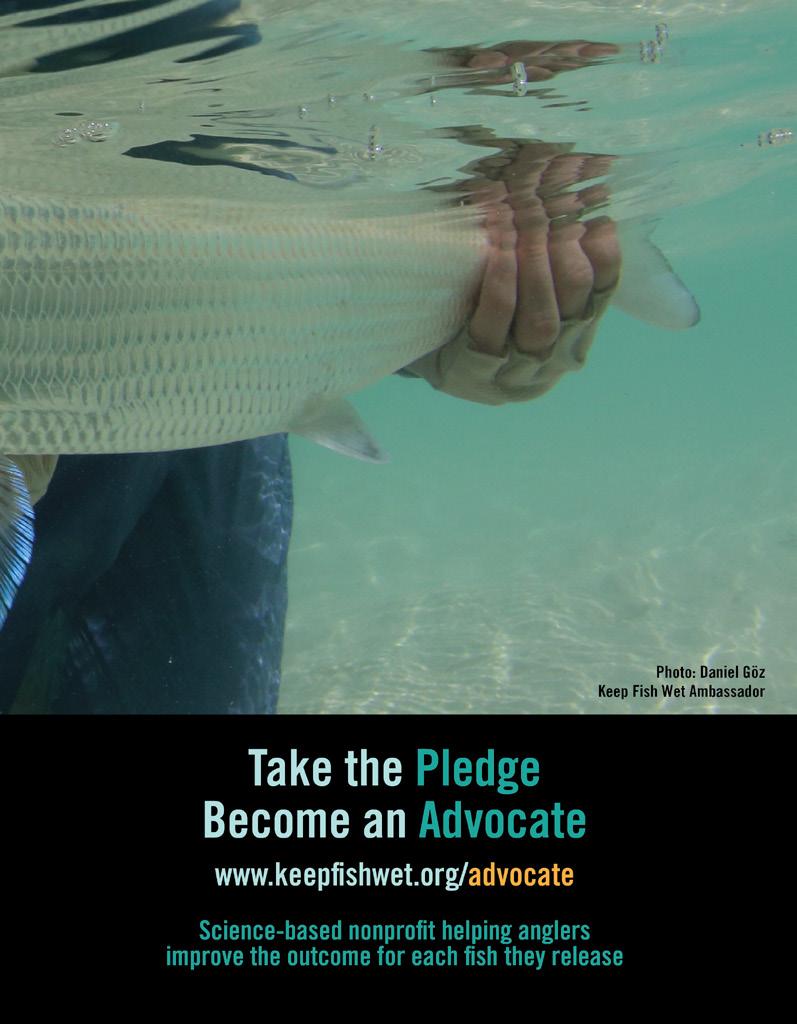


HERCULES JUST GOT STRONGER ... WWW.ALU-CAB.COM THE ALL-NEW UPDATED HERCULES ROOF CONVERSION AVAILABLE NOW and lighter, and sleeker, and smarter.






























































































 The author with a fine Soča River rainbow.
The author with a fine Soča River rainbow.
























































































































































































